
Navigation for News Categories
- Whakaari/White Island eruption: Victims awarded more than $10m in reparations

Photo: Supplied/ University of Canterbury
Victims of the Whakaari/White Island eruption and their families have been awarded more than $10 million in total reparations.
In the Auckland District Court on Friday, Judge Evangelos Thomas delivered sentences for five companies that took tourists to the volcanic island before the fatal eruption in 2019.
Twenty-two people died in the eruption and 25 others were injured .
He said reparations would be paid by the islands' owner Whakaari Management Limited, White Island Tours and the helicopter company Volcanic Air Safaris.
"I adopt an individual general sum of $250,000," Judge Thomas said.
"That calculation provides for total reparation of $10.21 million."
Judge Thomas said the exact reparation amounts would be tweaked in some cases.
"I make certain adjustments to recognise those who died leaving behind dependent children, other families whose children suffered serious emotional distress, families who lost more than one loved one, those survivors who also lost family members, and the few who were fortunate enough to escape without any serious injury."
He said each of the five companies involved had failed in their duties to assess and mitigate risk.

Judge Evangelos Thomas. Photo: RNZ/Marika Khabazi
"None of the defendants had any volcanology expertise, they had to get risk assessments done by the appropriately qualified people," he said.
"That failure [to do so] compromised everything else they did. That failure exposed others to risk of serious injury and death."
Whakaari Management Limited was fined $1.045 million and ordered to pay $4.88 million in reparations to all of the victims and their families.
White Island Tours, which took visitors to the island via boat, was fined $517,000 and ordered to pay $5 million in reparations to the victims involved in its tours.
Volcanic Air Safaris Ltd, one of three helicopter operators that conducted tours, was fined $506,000 and ordered to pay $330,000 in reparations to the victims involved in its tours.
Volcanic Air Safaris was the only helicopter operator on the island when it erupted.
Two other operators, Aerius and Kahu NZ, were fined $290,000 and $196,000 respectively but were not ordered to pay reparations.
GNS Science fined
GNS Science was the last party to be sentenced. The agency was fined $54,000.
Judge Thomas said it had failed to adequately communicate risk to contractors.
"The risk of harm was significant," he said. "While the risk of an eruption was low on any given day, the risk of serious harm occurring should an eruption occur while people were on Whakaari was always very high."
Thomas set the starting point for the fine at $90,000 and granted a 40 percent discount to reflect the agency's early guilty plea and record of public service.
As a Crown entity, Thomas noted that any fine would have to be paid via public funds.
"GNS observes that as a public body there will be a negative impact on the important service it provides given any fine would need to come from its operating budget," he said.
"However, the public interest in holding all entities including important public entities to account outweighs that."
'Today belongs to the survivors'
WorkSafe chief executive Steve Haszard said the victim impact statements delivered in court had showed the impact of the eruption was "far wider" than just the people who were on the island.
"Today belongs to the survivors, and the whānau and friends of those who were harmed or lost their lives," he said.
"One impact has been to raise our national understanding about the obligations on businesses to do everything they can to keep people safe. Whakaari is a catastrophic example of what can go wrong when they don't."
The companies' actions on the day of the eruption put people's lives in jeopardy, Haszard said.
"People put their faith in the businesses involved in these trips. But they were not properly informed about the risks, and they were not kept safe."
WorkSafe had a duty to hold businesses to account over the tragedy, Haszard said.
He described it as "one of the worst natural disasters in Aotearoa".
All of the businesses that had control over the island or that took visitors to the island had been convicted of health and safety failings, he noted.
Financial difficulties
Judge Evangelos Thomas acknowledged that the companies may struggle to pay the reparations.
"The awards I consider to be appropriate for emotional harm will stretch the resources of those able to pay them."
Whakaari Management Ltd, as a corporate trustee, did not have a bank account and therefore no funds from which to pay a fine. Thomas did not let that impact his decision, and he addressed the company's owners, Andrew, James and Peter Buttle, directly.
"I do not relieve WML from any of its reparation or fine obligations. There is nothing to stop the Buttles, as WML's shareholders, from advancing the necessary funds to cover that obligation.
"There may be no commercial basis for doing so, but many would argue there is an inescapable moral one. Some defendants responded to the tragedy with a preparedness to put their lives at risk to help others."
"We wait to see what the Buttles will do. The world is watching."
WML did not have liability insurance and therefore reparations would have to be paid out of pocket.
White Island Tours had insurance to cover reparations but had asked to be excused from paying a fine due to its financial position.
But Thomas said there was an overwhelming public interest in the fine being imposed.
"If WIT does indeed go into liquidation, the fine will simply be a debt that follows it and remains payable like any debt," he said. "I leave it to shareholders and liquidators to deal with."
He said the same principles applied to the helicopter operators, which were in a similarly weak financial position.
Copyright © 2024 , Radio New Zealand
Related Stories
'sheer recklessness' - whakaari victims' families speak in court.

The family of a couple killed in the Whakaari White Island eruption have told a sentencing judge they want the companies involved held to account.
Pain of son's death at Whakaari 'never goes away'
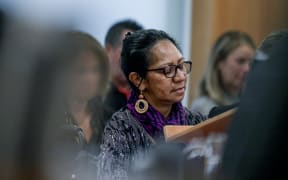
Family of 23-year-old tour guide Tipene Maangi broke down in tears as they spoke in court.
Whakaari survivors to tell of life-changing effects of tragedy
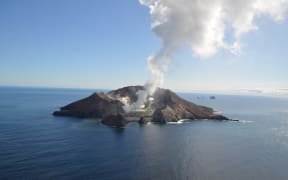
Survivors of the Whakaari White Island disaster will give accounts of how the tragedy forever changed their lives, when the sentencing of companies guilty of safety failings starts today.
Whakaari White Island: WorkSafe may have cast its net too wide, legal expert says
A legal expert says "complacency" within WorkSafe prevented the agency from achieving a better result during the Whakaari/White Island trial.
GNS Science pushes for lower fine over Whakaari failings
WorkSafe has argued GNS Science should be fined between $150,000 and $250,000 for failing to communicate the risks of flying to the island.
Whakaari/White Island
- Whakaari: Island's owners apologise 'unreservedly' to victims of 2019 eruption
- Whakaari/White Island eruption: Tour company cannot afford fines, likely to close
- Brother of guide killed on Whakaari/White Island says sentencing 'bittersweet'
- Whakaari / White Island parties face sentence
Get the RNZ app
for ad-free news and current affairs

Top News stories
- Inflation drops, borrowers take a gamble: Here's what moved the housing market this week
- Man who torched John Key’s electorate office admits $650k arson of Huntly Railway Building
- The places where you're most likely to pass your driving test
- Shortland Street: South Pacific Pictures pushes for change to govt screen rebate
- Israel attacks Iran, sources say, drones reported over Isfahan
Whakaari/White Island RSS
Follow RNZ News
- Election 2024
- Entertainment
- Newsletters
- Photography
- Personal Finance
- AP Investigations
- AP Buyline Personal Finance
- AP Buyline Shopping
- Press Releases
- Israel-Hamas War
- Russia-Ukraine War
- Global elections
- Asia Pacific
- Latin America
- Middle East
- Election Results
- Delegate Tracker
- AP & Elections
- Auto Racing
- 2024 Paris Olympic Games
- Movie reviews
- Book reviews
- Personal finance
- Financial Markets
- Business Highlights
- Financial wellness
- Artificial Intelligence
- Social Media
Survivors of New Zealand’s deadly volcano eruption will testify at a trial of tourism operators
FILE - Plumes of steam rise above White Island off the coast of Whakatane, New Zealand, on Dec. 11, 2019, following a volcanic eruption on Dec. 9. Three helicopter tour operators pleaded guilty on Friday, July 7, 2023, to safety breaches when New Zealand’s White Island volcano erupted in 2019, claiming 22 lives. (AP Photo/Mark Baker, File)
- Copy Link copied
WELLINGTON, New Zealand (AP) — A U.S. honeymoon couple who survived severe burns when New Zealand’s White Island volcano erupted in 2019 are listed as the first witnesses to testify in a trial of tourism industry operators over the disaster that claimed 22 lives.
Prosecutors open their case in the Auckland District Court on Tuesday on health and safety charges against six companies and directors in the Dec. 9, 2019, volcanic eruption at the popular tourist attraction.
Matt Urey and his wife, Lauren Barham, from Richmond, Virginia, were listed on Monday as the first witnesses to testify.
British helicopter pilot Brian de Pauw and Australian tourist Annie Lu are also high on the witness list.
The American couple were among 47 people on White Island, the tip of an undersea volcano also known by its Indigenous Maori name Whakaari, when superheated steam erupted, leaving most of the 25 survivors with severe burns.
Many people question why tourists were allowed to visit the island after experts monitoring seismic activity raised the volcano’s alert level two weeks before the eruption.
Urey and Barham were among tourists who had been traveling from Australia aboard the Royal Caribbean cruise ship Ovation of the Seas.
Of those killed, 14 were Australian, five were American, two were New Zealanders and one was from Germany.
The island’s owners, Andrew, James and Peter Buttle, directors of Whakaaari Management Ltd., are among those charged.
Three helicopter tour operators pleaded guilty last week to safety breaches and avoided the judge-only trial, which is scheduled to last 16 weeks.
Each of the organizations faces a maximum fine of 1.5 million New Zealand dollars ($927,000). Each individual charged faces a maximum fine of NZ$300,000 ($185,000).
New Zealand begins sentencing of those involved in White Island volcanic eruption
- Medium Text

Coming soon: Get the latest news and expert analysis about the state of the global economy with Reuters Econ World. Sign up here.
Reporting by Lucy Craymer; Editing by Stephen Coates
Our Standards: The Thomson Reuters Trust Principles. New Tab , opens new tab

Russian missiles hit the port of Pivdennyi in Ukraine's southern Odesa region on Friday, damaging Ukrainian and Singaporean facilities at the site, President Volodymyr Zelenskiy said.

World Chevron

Insight: Israel's Iran attack carefully calibrated after internal splits, US pressure
The decision to hold back from broader and immediate action underlined the competing pressures on Benjamin Netanyahu's government after Iran launched more than 300 drones and ballistic and cruise missiles at Israel last Saturday.
The United States on Friday imposed sanctions on an ally of Israel's far-right national security minister and two entities that raised money for Israeli men accused of settler violence, the latest actions aimed against those Washington blames for an escalation of violence in the Israeli-occupied West Bank.

California prosecutors announced involuntary manslaughter charges against three police officers for the 2021 death of a man in their custody, reversing the outcome of a previous investigation that had cleared the officers.
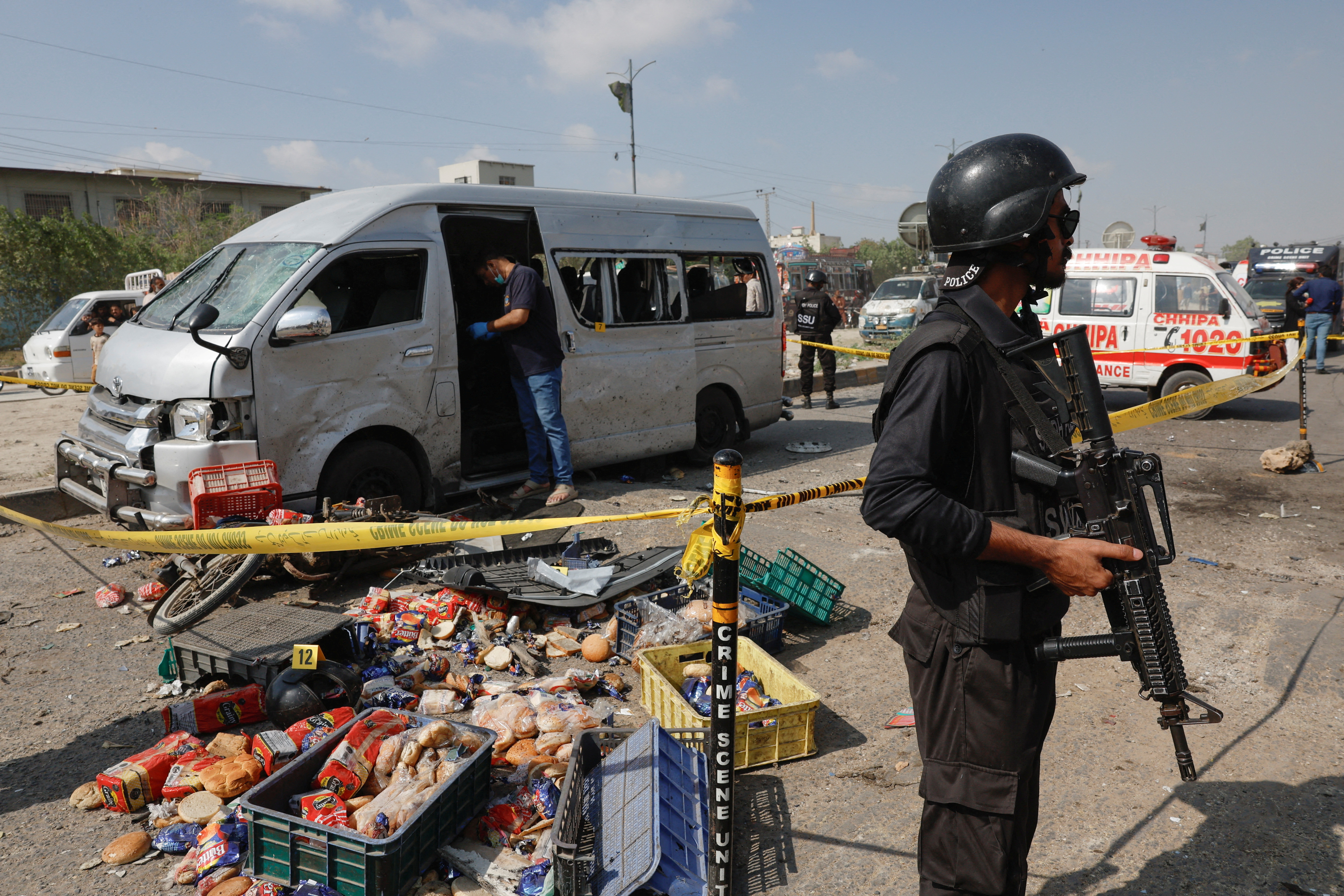
- Science & Environment
History & Culture
- Opinion & Analysis
- Destinations
- Activity Central
- Creature Features
- Earth Heroes
- Survival Guides
- Travel with AG
- Travel Articles
- About the Australian Geographic Society
- AG Society News
- Sponsorship
- Fundraising
- Australian Geographic Society Expeditions
- Sponsorship news
- Our Country Immersive Experience
- AG Nature Photographer of the Year
- Web Stories
- Adventure Instagram
What really happened on Whakaari/White Island?

THE ERUPTION BEGAN at 9.35pm with big heaves inside the crater. By 10.03pm it was pelting the nearby walking track with projectiles, but withheld its final energy until 10.11pm, when with a whoomph it sent a plume sky-high. A scalding current of steam and debris, coloured green by hydrothermally altered rock, rolled right across the track at 11m/s, and down to the south-eastern bays.
This eruption took place on Whakaari/White Island, New Zealand, on 27 April 2016, more than three years before the catastrophe in December last year that claimed the lives of 21 people (17 of them Australians) and injured 26 others.
Geologists from GNS Science, NZ’s leading provider of geoscientific research, reconstructed the pulses of the eruption from acoustic and seismic data, and, three weeks later when they could safely land on the island again, began figuring out the reach of those pulses.
The resulting scientific paper was published on 1 April last year, and its authors warned: “These eruptions clearly pose a significant hazard to the tourists that visit the island.” More than a quarter of the walking track had been bombarded by rock fragments. The pyroclastic surge, though just 5mm thick at its extremities, had nonetheless covered 95 per cent of the track.
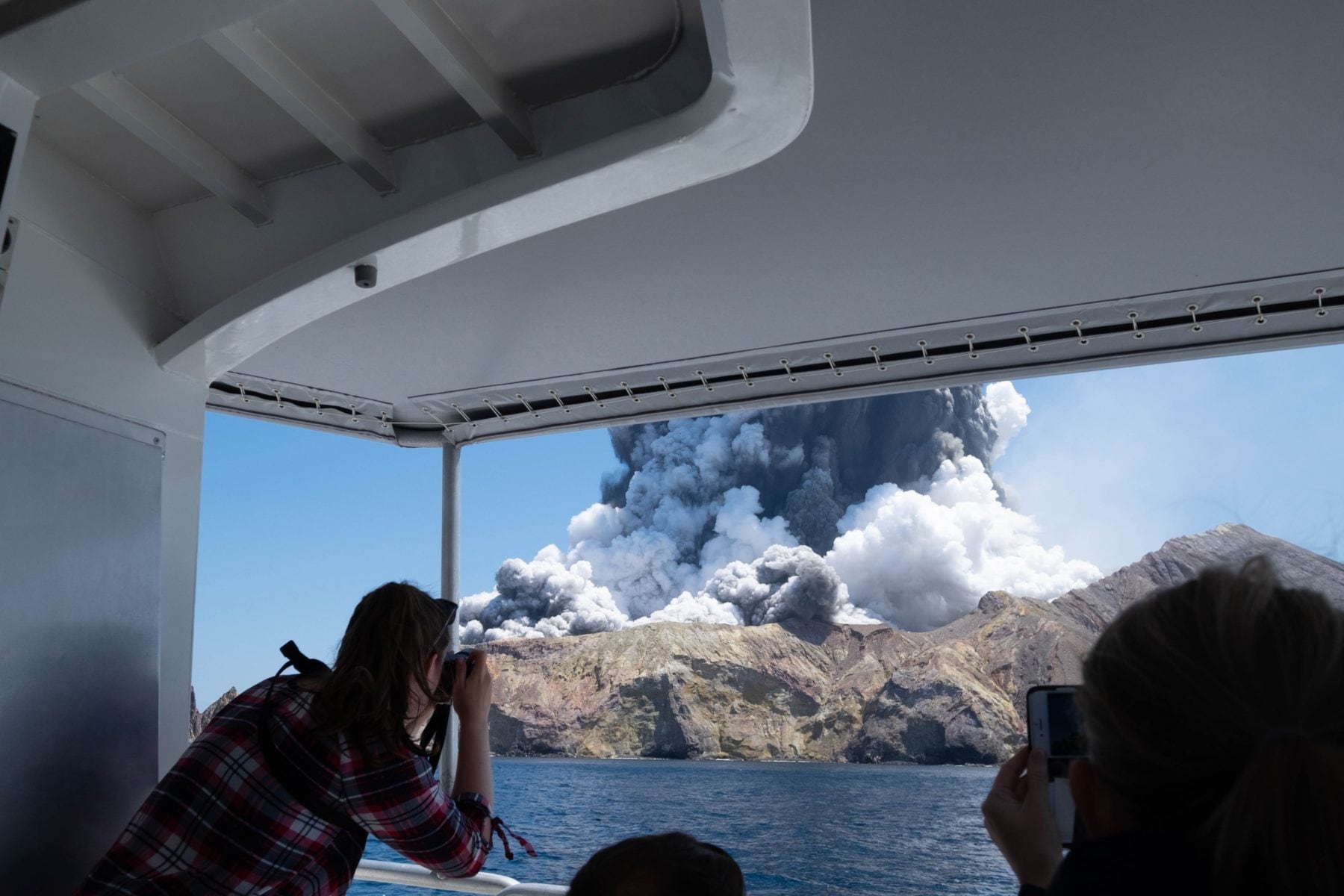
You might wonder if this eruption triggered any changes, but it happened at night, with no witnesses, so it simply passed on by. You might, therefore, be tempted to wish it into the daylight, when tourists would have been afoot, because then it might have garnered more notice – since it came in pulses of ascending violence, there would have been time to run, and the headlines would have been nothing more than “Tour operators reassess risk after near miss”. It would have been a wake-up call that produced only meetings over cups of tea, with scribbled notes, bottom-line business interests weighed against risk, and some kind of agreed reform.
Three years later, at 2.11pm on 9 December 2019, there was another eruption – one that came without warning. Except, perhaps, that on 8 December the instruments that measure tremors in nanometres momentarily spiked 30 per cent higher than any tremor during the previous two months. Or perhaps for a moment during a video shot by tourist Allessandro Kauffmann earlier in the afternoon. Kauffmann was part of the group aboard Phoenix , a White Island Tours vessel, and he videoed much of the island tour. At about 1.30pm, he panned along the hot, strangely bright stream flowing from the crater lake. Amid the snap and spit of boiling mineral water, the microphone caught an off-camera aside by a White Island Tours guide: “I’m a little bit worried why it’s going green.”
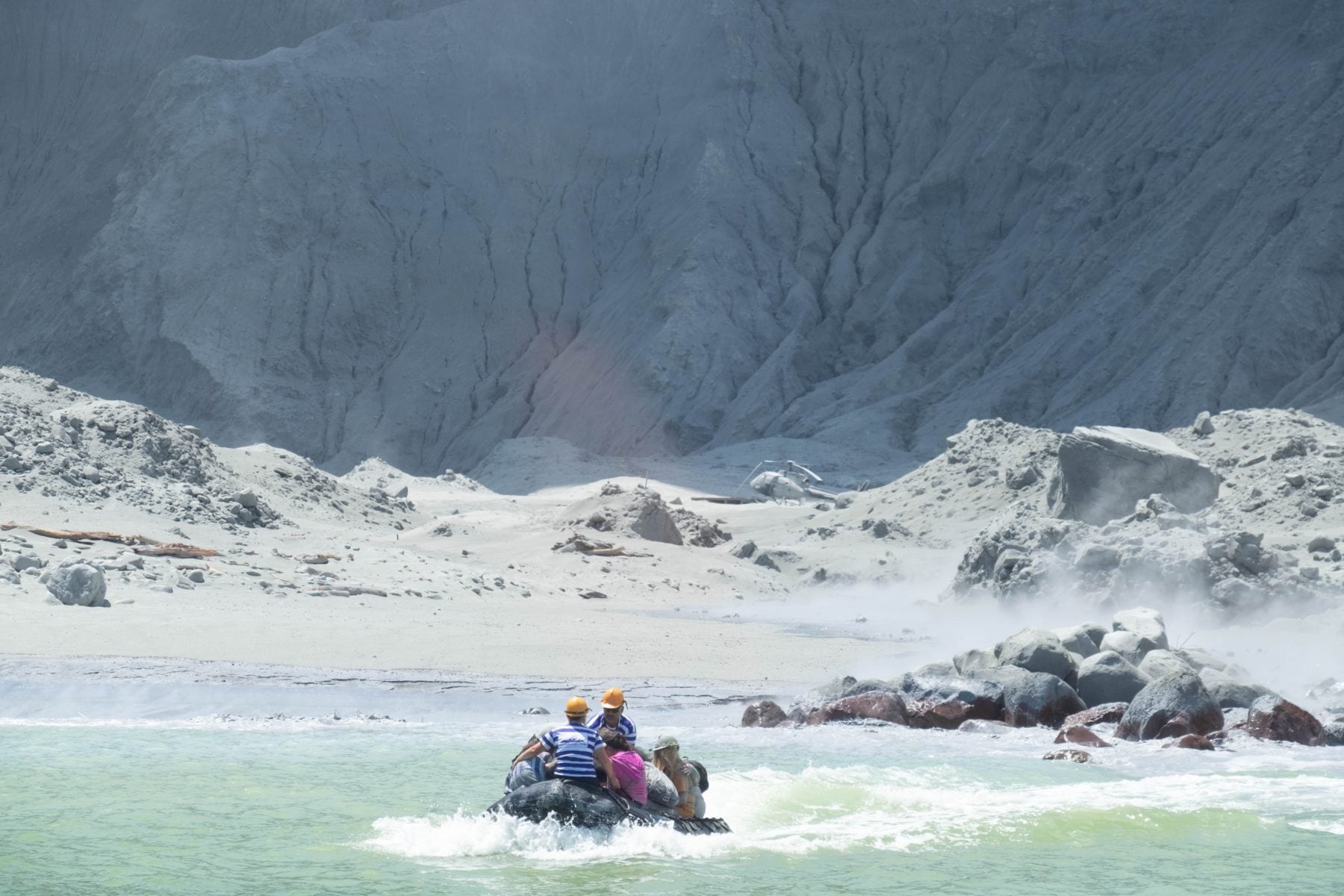
Whakaari’s dangerous charm
Attitudes to Whakaari have long been cavalier. In 1914 miners drained the crater lake to uncover deeper deposits of sulphur. Geologists suspect this affected the stability of the crater cliffs, because in September that same year, a 300m-wide chunk collapsed. As it fell, the rock, weakened by heat and saturated with water, mutated from an avalanche into a highly fluid lahar (a violent type of mud or debris flow), which ran for more than 1km eastward to the sea, burying the 11 miners and destroying the sulphur factory.
Then, during Whakaari’s long eruptive phase from 1976 to 1982, the keen young geologists of the NZ Geological Survey’s Rotorua office put together the first comprehensive analysis of the volcano’s mighty hydrothermal systems. They were often photographed as minute specks against vast up-rushing columns of steam, or in front of dark umbrellas of mud thrown up by the vents. They were out there for hours, measuring the gradual expansion or contraction of the crater floor, even when the volcano was – to use their word – “ashing”, the grey flakes coating their hair and clothes.
“We took risks and didn’t even think about it,” says Ian Nairn, who was one of that group. “We often went out straight after a serious eruption. It was our job, our interest, and the main problem was how long it took to organise a boat or a helicopter.”
Peter and Jenny Tait first became similarly transfixed by the volcano’s dangerous charm when they took a group from Germany on a fishing charter, but, at the Germans’ impulsive request, finished up exploring the island. The Taits built a business out of taking tourists to stand at the junction of the real world and the unruly energy of the underworld: the strange colours, the steaming lake, the crater cliffs painted bright yellow at their base and then rising almost vertically to 300m, cupping the humans below within a thrilling amphitheatre.
“That first trip was in 1990,” Tait tells me, “and, as it developed, Jenny and I were taking six people a day there. It was very personal. The reaction of the punters was, ‘It’s unbelievable,’ and that’s what drove us to keep developing it.”
In 2017 the Taits sold their business, White Island Tours – a 27-year-old enterprise that came with a motel and cafe – to Ngati Awa Group Holdings, which kept on many of the Taits’ employees.
“Safety?” Tait says, when asked about the potential risks of taking visitors to an active volcano. “We were more worried about the Whakatane River bar than the island erupting, to be honest. There were so many things. It was an adventure trip. You have to cross the river bar. You have to cross pretty rough ocean, then get into an inflatable and land, with very tricky conditions, to get onto the island at times. And you’re on the island a very short time, really. The overall chances of it erupting seemed pretty small.”
On the afternoon of 9 December, Tait was sitting in his lounge, high on the rocky ridge that overlooks Whakatane and out across 50km of blue ocean to Whakaari. He saw the eruptive column’s silent rise. He didn’t know if there were people on the island or not.
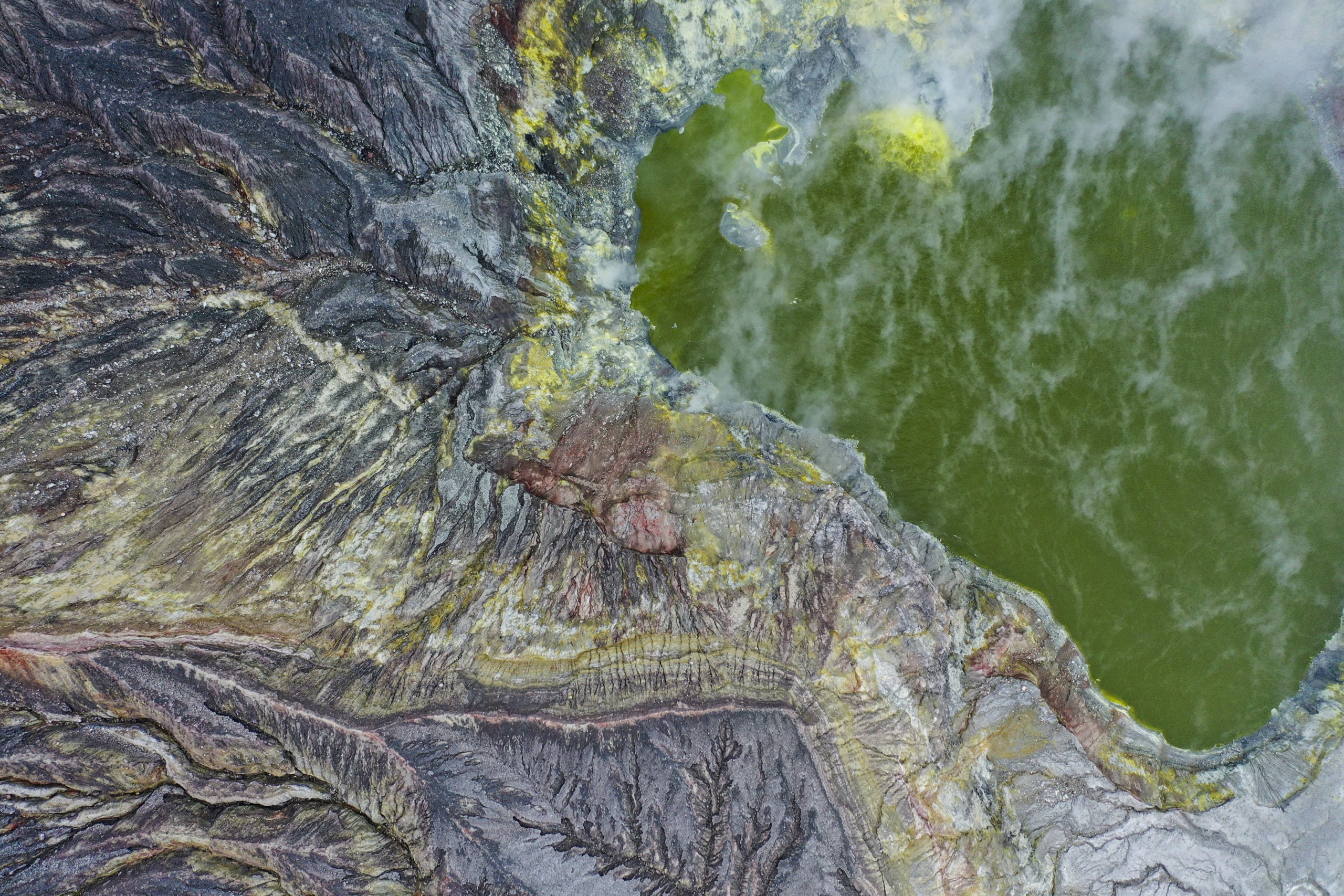
The rescue mission
Those aboard Phoenix knew. At about 2pm, passengers had returned to the vessel, which was moored in Te Awapuia Bay on the south-eastern corner of the island. Phoenix motored north around Troup Head, giving its passengers one last photo opportunity directly up the crater, before it turned south to return to Whakatane.
It was right at that moment, to gasps of pure wonder, that the eruptive column boiled into the sky. Then the column darkened at the base, and a sinister ground-hugging wave steadily overwhelmed the island, billowing towards the vessel. The framing on every camera went up, down or sideways, jerking with fear.
The skipper accelerated clear of the ash cloud, and for his passengers the eruption was no more than a terrible fright. But there were people on board who knew that White Island Tours’ new flagship vessel, Te Puia Whakaari , was still moored back at Te Awapuia Bay, and that its tourists were still on shore. That meant 38 passengers from the cruise liner Ovation of the Seas , plus four guides.
Meanwhile, the Rotorua-based company Volcanic Air had brought four tourists to the island on a Squirrel helicopter that the company’s pilot and guide had set down on a landing pad behind the ruin of the sulphur factory. That made 47 people still on the island.
At 2.14pm, Phoenix sent out an emergency call to Coastguard Whakatane, advising of an eruption and requesting urgent medical evacuation. Phoenix then sped back to Te Awapuia Bay, and called the coastguard again at 2.16pm, confirming casualties. Minutes later, Te Puia Whakaari also contacted the coastguard. The three calls triggered a Civil Defence emergency, alerting police, St John Ambulance services, rescue-helicopter services and hospitals on the mainland.
But Whakaari lay across 50km of rough ocean, far from any immediate help. As national agencies began to tool up, the locals were already organising their own ship-to-shore and air-to-ground rescues.
At Te Awapuia Bay, the ash had already cleared. The sky was once again blue and the sun shone, but Te Puia Whakaari and the island itself were a dull, flat grey. Phoenix ’s skipper kept his engines running, ready to speed clear if the volcano blew again.
Paul Kingi was a senior skipper and the tours manager at White Island Tours, but he’d joined Phoenix that morning simply as a guide and was free of any captain’s responsibility to stay with the vessel. He took immediate charge of the rescue, loading two crewmates into Phoenix ’s inflatable, then gunning its motor to intercept a woman swimming towards Te Puia Whakaari . After plucking another two women from the water, he took all three to Phoenix . Then he turned to the dozen or so people, grey with ash, who were huddled on or near the island’s landing.
As the sea-to-shore rescue got underway, an air-to-ground rescue was assembling. The rising plume from Whakaari had served as a shrill alarm for pilots from Whakatane, Rotorua and Taupo. Mark Law, head pilot of Whakatane-based helicopter operators Kahu NZ, saw the eruption as he drove back from Tauranga in his car. He got on the phone, and the Kahu base confirmed that GNS Science’s monitoring cameras on the island had blanked out. Simultaneously, high above the blue expanse of the Bay of Plenty, a helicopter pilot who had lifted off from Whakaari just six minutes earlier called his head pilot, Tim Barrow, at Volcanic Air, and described the scale of the eruption. Barrow then called Law.
Meanwhile, retired helicopter rescue pilot John Funnell was in the air in a small fixed-wing aircraft near Whakatane, keeping up his flying hours. As two Kahu choppers prepared to lift off for Whakaari, with pilots Law, Jason Hill and Tom Storey aboard, Funnell was enlisted as ‘top cover’, a specific role within emergency operations – the top cover is the fixed-winger that circles high above the scene and transmits information received from the team below.
So a small airborne unit was formed, bound together not by official roles or rehearsals, but by the natural meshing of grave concerns and aided by local knowledge of landing pads within the crater.
By then, the sea-to-shore rescue was closing up, and Phoenix had become a de facto hospital ship. Kingi’s inflatable had delivered the people on the landing to the vessel, including the four Volcanic Air tourists and their pilot. Three of those five were probably the luckiest people on the island that day, because when the volcano blew they were already at the shoreline, the last point of interest in their hour-long tour. The pilot urged them into the water, and he and the two who immersed themselves escaped serious injury. The other two hesitated, and were later hospitalised for burns.
Kingi, back on the island, had gone inland on the walking track towards the crater to find more survivors and help them down to the inflatable. The last person Kingi found, just as he had decided to stop searching, was 19-year-old Australian Jesse Langford, who stumbled down towards him. Jesse had been more than 300m inland when the volcano blew. He was his family’s only survivor, because his father, Anthony, mother, Kristine, and sister, Winona, passed away around him.
At about 2.45pm, Phoenix took off for Whakatane. The Kahu helicopters above and the vessel below crossed paths just before 3pm, and Law swooped low, the urgency of his mission and the scale of it confirmed by the sight of prone people being tended to on the back deck.
Those who had sustained the worst burns had been placed at the front of the vessel, and two doctors had stepped forward from among the passengers to tend to them – a general practitioner on holiday from the UK, and another from Germany.
Geoff Hopkins, a pastor at Arise church in Hamilton with a St John certificate, also provided assistance. He dug deep into remote first-aid training he’d done in the UK, but he was dealing with people drifting in and out of consciousness, people who were saying, “I’m not going to make it.” So he dug deeper yet, into his faith, and told them, “You’re not going to give up.”
His daughter, Lillani, was at the back of the vessel with the other victims, doing her best to stave off hypothermia and shock. She found herself singing the evangelical song “Waymaker”:
You are here – moving in our midst…
You are here – working in this place…
You are here – healing every heart…
And if she stopped there’d be a touch on her leg, and a whisper: “Keep singing.”
Halfway back, Phoenix was met by a coastguard vessel delivering paramedics and pain-relief medication.
About 3pm, the Kahu helicopters entered the crater airspace, and Law descended to 200 feet for a closer look. The centre of the island was now mostly clear of steam and ash. He saw some figures lying down, and others sitting – there were people alive down there. The Kahu pilots set their choppers down on the crater floor and got out of their machines, scuffing through the grey ashfall, amid dense gases and drifting ash.
Breathing was difficult, even with gas masks. They assessed the dead, the dying and the living. Through a handheld radio – they had to remove their gas masks to speak into it – they described injuries to Funnell, their top cover, who relayed the information to Whakatane Hospital.
The fliers felt the desperation in everyone they encountered, and their response was to talk back, to comfort, to tell each person, “We’re here. We’ll get you out,” before moving on to the next person. Law got word that the big air ambulances were still being staged at Whakatane, so any immediate rescue was up to them. The most badly injured – by ballistics as well as scalding – were those nearest the crater. The Kahu team hopped one of the choppers further up into the threatening miasma to get them, loaded five people, and Hill took off for Whakatane Hospital. Below him, out of the steamy cauldron that had produced the lethal blast, the volcano suddenly started ashing.
By now, it was about 3.40pm, and Barrow was settling his helicopter onto a landing pad by the shore. He’d flown in from Rotorua with pilot Graeme Hopcroft. Funnell had updated them on conditions, and they raced up to the crater to join the search. They half-carried one survivor to their chopper, then joined the Kahu crew to assist five more survivors into Law’s machine. Law lifted up and out for Whakatane. Barrow, Hopcroft and Storey loaded one more survivor into the Volcanic Air helicopter, then Barrow and Hopcroft fired it up and banked south for Whakatane.
For a time, Storey was left alone. He spent the next half-hour grouping bodies for later retrieval. Among the bodies was his friend, White Island Tours guide Hayden Marshall-Inman. A second Volcanic Air helicopter arrived to pick up Storey, and completed an aerial reconnaissance of the crater.
By then it was all but over.
Two Westpac air-ambulance helicopters arrived, one circling on standby above the crater, while the second landed St John medical director Tony Smith and three other clinicians on the eerie domain below. They checked the bodies for signs of life, and confirmed no survivors were left behind.
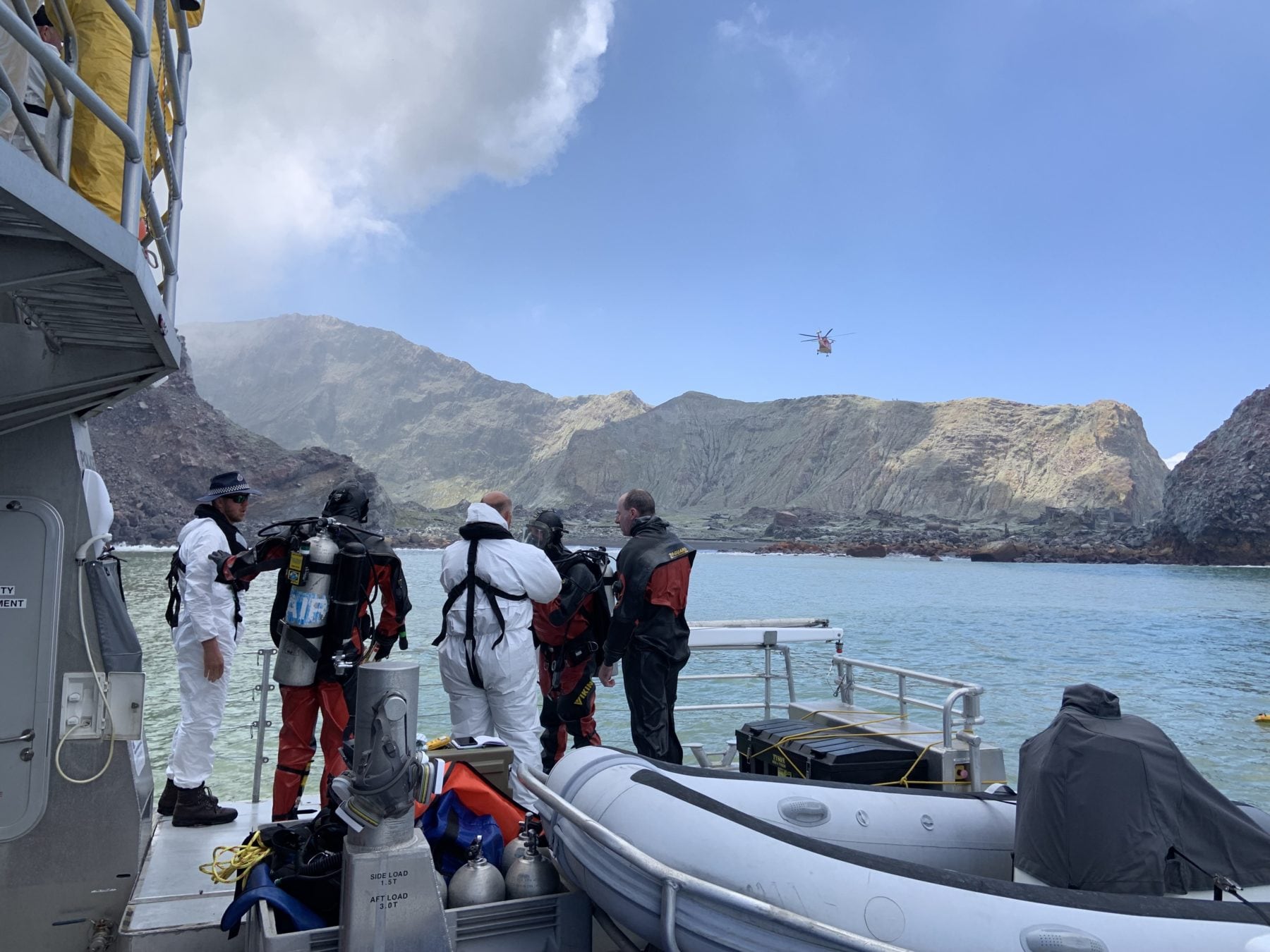
The science behind the eruption
In geological terms, the steam-driven eruption on 9 December was a small one, similar in energy and range to the 27 April event three years earlier. One significant difference was that it happened more quickly.
Shane Cronin, professor of volcanology at the University of Auckland, compares the 9 December eruption to a giant pressure cooker blowing its lid. Whakaari’s “lid” consisted of layers of sulphur, salts and weakened rock, which were metres deep. These were blasted away to form an entirely new vent. When this lid blew, a pressure wave fled across the island at supersonic speed, invisible but forceful enough to knock gas masks off the faces of tourists and guides and to shift Volcanic Air’s 1.3 tonne Squirrel helicopter half off its landing pad.
Then an eruptive column of steam and ash climbed into the sky, perilous to any who stood close by.
But the most lethal event in the eruptive sequence was the third: a dense, ground-hugging pyroclastic surge, which flowed from the vent, over the walking track and right down to the eastern shoreline.
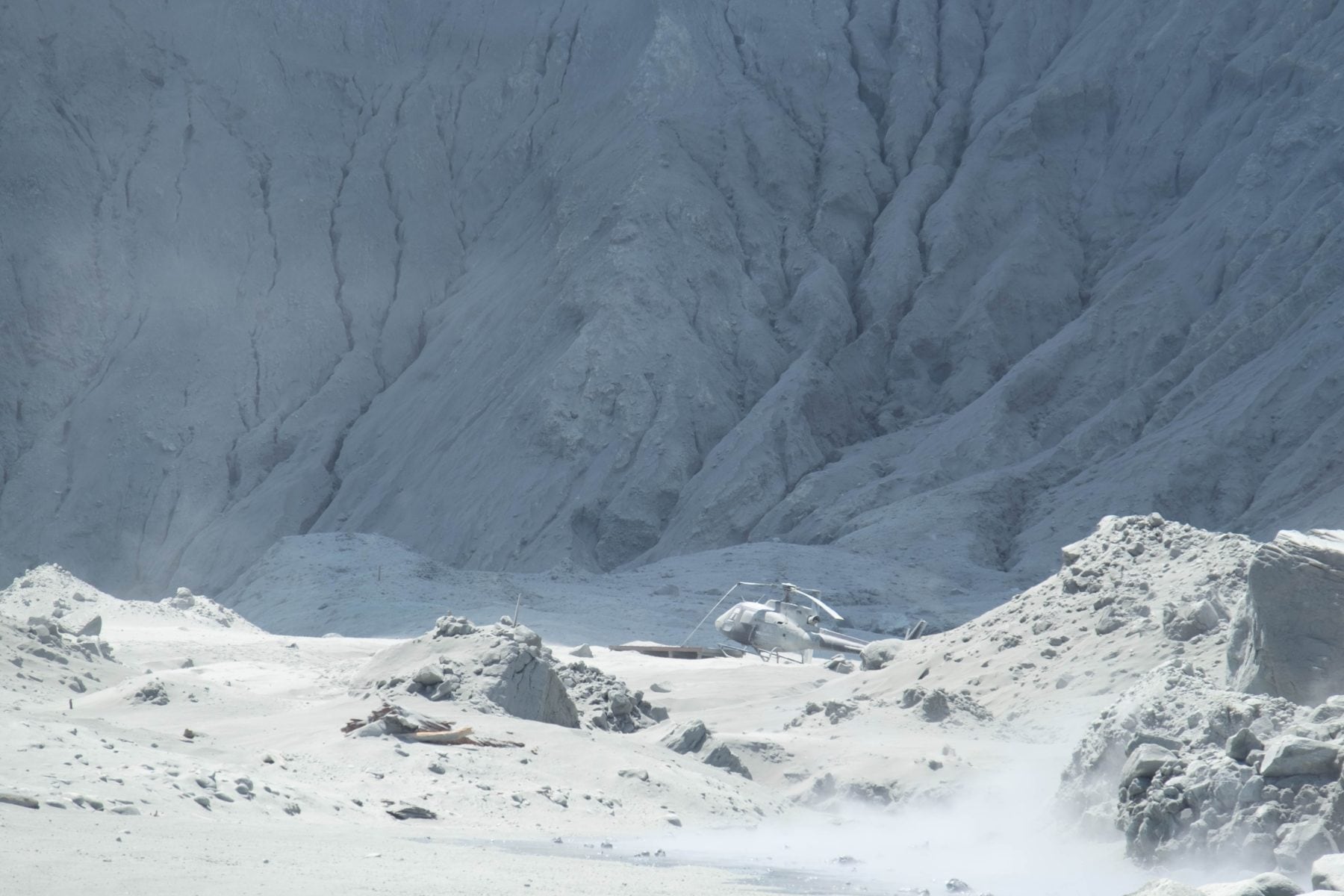
Cronin calculates from past studies of steam-driven eruptions on Whakaari that this surge would have burst from the crater at 300ºC and 100km/hour, losing force and heat in the ambient air as it rolled east. It was still boiling hot but had slowed to about 25km/hour when it flowed into the sea.
The surge was mainly formed of steam and ash, but carried within it a “salty aerosol”, says Cronin. Past testing of residues from this type of eruption has found them to consist mostly of fine fragments of pulverised rock coated in sulphur and acid salts, which turn into concentrated droplets of sulphuric acid when they come into contact with air, water or human skin. The remaining residues are hydrochloric acid and small amounts of hydrofluoric acid, which is the most corrosive of the residues, especially if inhaled.
Although the Squirrel helicopter was 1km away from the eruptive vent, its rotor blades flapped up and down like a bird’s wings in the turbulence of the pressure wave. Then the pyroclastic surge plastered it with ash. Afterwards, it sat stranded in the grey surrounds, grievously damaged, its carbon fibre and aluminium rotors broken and drooping, undone by nature’s power.
Calculating the devastation
The eruption had triggered a national emergency, and leadership had been formally handed to Bay of Plenty’s Civil Defence Emergency Management Group, with police the lead agency for search and rescue, and for recovery. The helicopter pilots had operated independently of the official system, but fell under its command once they landed and were stood down.
Eight bodies still lay on the island, two of them White Island Tours guides – Tipene Maangi and Hayden Marshall-Inman. As public pressure rose by the day to recover the Whakaari dead, Marshall-Inman became a symbol for all eight. The 40-year-old was well liked within the communities of Whakatane and Ohope, and he’d been with White Island Tours for many years.
A sense of frustration was growing in Whakatane, fuelled by outside control swooping in and sidelining local pilots, quarantining tour boats without properly cleaning them of corrosive ash, and suggesting – wrongly – that there was a criminal inquiry into White Island Tours. The town’s diffuse anger found focus on delays in the recovery.
But police were responsible for ensuring no further casualties, and the GNS Science seismometer on Whakaari was laying down a continuous recording of the volcano’s quivering energy.The volcano had erupted out of nowhere, and might do so again. In the hours after the eruption, the island was relatively quiet – and, in retrospect, this was the window for recovering the bodies.
Indications of unrest became more pronounced on Tuesday 10 December when the tremors began again, and on Wednesday and early Thursday the tremors peaked at levels well above the eruption itself. On Thursday evening, the tremors fell away sharply, and continued to fall on Friday, when the NZ Defence Force landed on the island at first light.
It was a team of eight, including six bomb disposal specialists, kitted out in three protective layers, with breathing apparatus and four hours’ worth of air. The work they did was exhausting. Around the active crater area, they waded through dense, hot, acidic mud, but they collected the bodies, and prepared them for final retrieval by helicopter to HMNZS Wellington , which was waiting offshore.
They recovered six bodies, but two had gone. Marshall-Inman and Winona Langford had been 800m away from the eruption, and 300m from the shoreline, but a violent rainstorm had swollen the stream near where they lay, and washed them into the sea. Police would later say that, while patrolling in Te Awapuia Bay, they’d seen a body believed to be Marshall-Inman near the landing, but couldn’t get close enough to recover it, and called in a Navy inflatable. In rebounding waves, the Navy personnel were unable to take the body aboard, and the rough sea allowed no second chance.
Resigned to the lack of any formal goodbye, the Inman family organised a celebration of life at the Whakatane Baptist Church on 20 December. Maangi’s photo was on display, too, and hundreds attended. The mourners heard from the helicopter-pilot rescuers that both Marshall-Inman and Maangi had tried to help members of their tour groups before they’d finally succumbed. Monday 9 December had been Marshall-Inman’s 1111th venture onto the island, and each one of them, except the last, had been recorded in his diary.
A few weeks later, Marshall-Inman’s brother Mark Inman and friends rode jet skis out to Whakaari, and sat on their craft in Te Awapuia Bay. After the long haul out to the island, the eight riders opened cans of beer and performed their own karakia – Maori incantations and prayers, used to invoke spiritual guidance and protection – to their friend and brother, and to all those who’d lost their lives.

‘Bunyip’ bird returns to restored Tasmanian wetlands
For the first time in more than 40 years, the distinctive booming call of the endangered Australasian bittern once again rings out across the waters of Tasmania’s Lagoon of Islands.

Indigenous rock art sites ‘chosen’ for vantage
Researchers have discovered internationally significant rock art sites in Arnhem Land were far from random and instead “chosen” for the critical vantage points they provided.

Defining Moments in Australian History: Australia’s first Olympian
1896: Edwin Flack races into history.
Watch Latest Web Stories
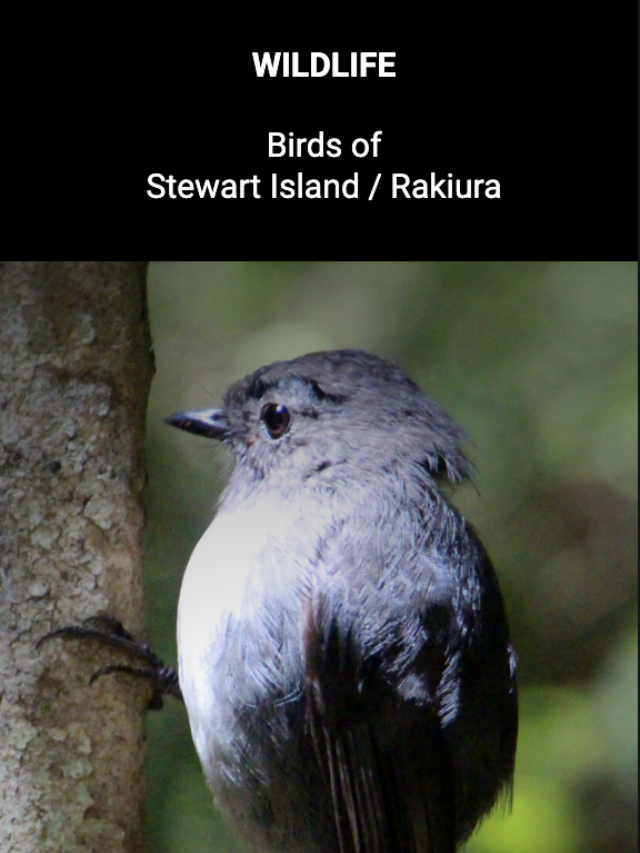
Birds of Stewart Island / Rakiura

Endangered fairy-wrens survive Kimberley floods
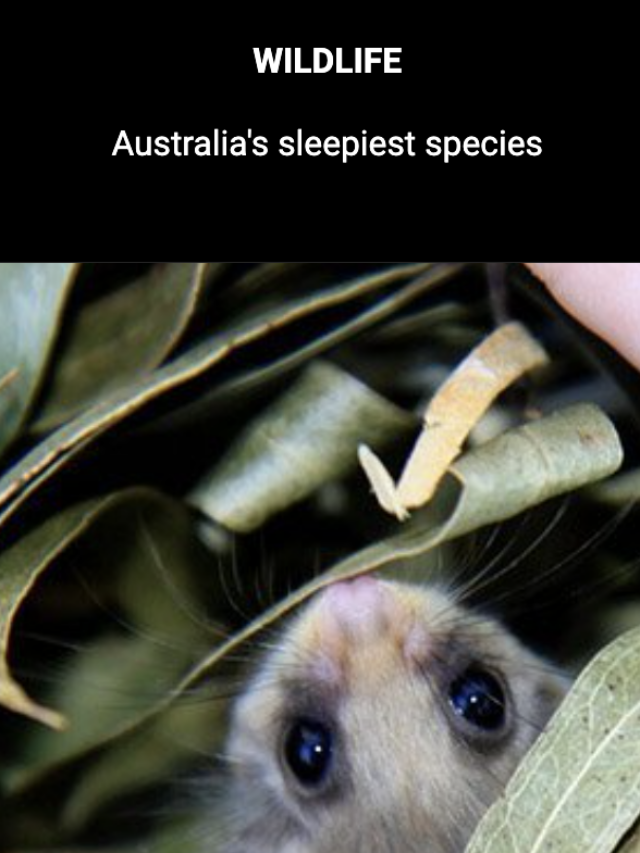
Australia’s sleepiest species
- SYDNEY, NSW
- MELBOURNE, VIC
- HOBART, TAS
- BRISBANE, QLD
- ADELAIDE, SA
- CANBERRA, ACT
Win for victims of NZ volcano eruption suing cruise operator

- New Zealand Volcano Eruption
- Cruise Ship
Send your stories to [email protected]
Auto news: 'They don't have reverse?' Tesla parking causes outrage
Top Stories

'I tried to help him': Bondi Junction security guard recalls moment colleague was stabbed

TODAY IN HISTORY: Violent ending for notorious Australian crime lord

Shoppers urged to be sensitive as Bondi Westfield reopens

Truckie's widow fights for industry change after fiery SA Highway crash
latest in US News

Conjoined twin Abby Hensel's husband's paternity results revealed...


Rep. Claudia Tenney unveils bill to defund 'partisan propaganda...

Republicans eye ex-DNC chair, Biden adviser Tom Perez over...

NYC teen stabbed to death by neighbor over parking spot: police...

Environmentalist ex-colleagues demand RFK Jr. drop out of 2024...

Dr. Phil speechless after real estate agent says squatting is...

House readies Saturday vote on $95B in Ukraine, Israel and Taiwan...

Female college student fights back against armed robber and yanks...
Live updates, devastating video shows cruise ship tourists fleeing for their lives from erupting volcano: ‘run, run’.
Thanks for contacting us. We've received your submission.
Shocking footage of the White Island eruption shows the moment cruise ship tourists watched the volcano erupt.
The majority of the victims of the December 2019 disaster were passengers on board the Ovation of the Seas who traveled to the island as part of a tour group.
The video shows a group of about 18 passengers and guides in hard hats standing on an elevated part of the island gasping in awe as grey steam emerges from the top of Whakaari’s crater.
However, within seconds the mood changed, with the group breaking out into a run as they realized the seriousness of the situation.

Guides could be heard screaming “Run, run” and “Come on follow me” as others hid behind large rocks in the hope of saving themselves.
Meanwhile, a woman was captured tripping onto her knees as the rest of the group sprinted ahead of her.
Screams can be heard as dark ash and burning gases fill the air.

Most of the tourists never stood a chance , with just three of the 25 people on the island surviving.
Tuesday marked the first day of an anticipated 16-week trial, with the video one of many to be released after being recovered from victims‘ devices.
Most of the victims were understood to have come from Australia and were allegedly not warned of the tour risks prior to setting foot on the island.

At the time, the island sat at Volcanic Alert level two which is defined as a “moderate to heightened unrest”.
This fact was disclosed in another piece of footage shared at the hearing.
“The higher the level, the higher the risk of an eruption,” a guide told a tourist as they walked towards the crater, according to the New Zealand Herald .

“We’re at level two, nearing level three now.”
It’s understood level three is categorized as a “minor volcanic eruption,” with the highest rating level five meaning there’s a chance of seeing a major volcanic eruption, according to GeoNet .
The owners of the island as well as their company are on trial following the incident and are facing charges under the Health and Safety at Work Act (HSWA).

Acting for WorkSafe, lawyer Kristy McDonald KC said they failed to take adequate steps to prevent serious injury or death, with some of the group already pleading guilty to other charges and awaiting sentencing.
Brothers Andrew, James, and Peter Buttle jointly own the island which has been passed down in their family since 1936, with their company Whakaari Management Ltd (WML) also on trial.
They have denied wrongdoing.

“The businesses making their money from tours on to the volcano had clear duties under HSWA,” Ms McDonald said.
Never Miss a Story
Sign up to get the best stories straight to your inbox.
Thanks for signing up!
Please provide a valid email address.
By clicking above you agree to the Terms of Use and Privacy Policy .
Never miss a story.
“They failed to comply with those duties, and the end result was that tourists and workers went to the crater of an active volcano without being advised properly of the risk.”
On behalf of WorkSafe, Ms. McDonald added the brothers and the company failed to properly assess the risk the volcano posed to tourists venturing to the island, with few evacuation measures in place for such traumatic events.
“The limited things WML did in terms of infrastructure fell well short of their duty to ensure there was an adequate mechanism for evacuation,” Ms McDonald said.
“Profit should never come before safety,” she added, noting the company made an annual profit of $1 million.
Also facing trial are businesses Tauranga Tourism Services Ltd and ID Tours New Zealand LTD, which had exclusivity agreements to operate tours on Whakaari.
Ms McDonald said these businesses in addition to WML failed their duty to inform guests of the risks of visiting the island.
“Information regarding cancellations due to weather or information for invoicing purposes passed through the supply chain successfully. Safety information was not given the same attention,” she said.
“The case is not that the information received was inadequate. Those passengers did not receive any information in terms of volcanic activity.”
It’s anticipated more evidence will be shared as the trial continues for the next four months.
Share this article:

Advertisement
Watch CBS News
Charges filed year after volcano eruption kills 22 in New Zealand
November 30, 2020 / 12:37 PM EST / CBS/AP
New Zealand authorities filed safety violation charges on Monday against 10 organizations and three individuals after a volcanic eruption at White Island last year killed 22 people. The island had been a popular tourist destination before the December 9 eruption, but many people now question why tourists were allowed to visit, especially after experts monitoring seismic activity raised the volcano's alert level two weeks before the eruption.
The names of those charged are being kept secret for now by authorities under New Zealand legal rules.
But two agencies which rely on public funding have disclosed they are among those charged: GNS Science and the National Emergency Management Agency. Some of the others charged likely include private companies which took tourists to the island. The individuals charged were either company directors or managers.
Each of the organizations faces a maximum fine of 1.5 million New Zealand dollars ($1.1 million). Each individual charged faces a maximum fine of NZ$300,000 ($211,000).
The charges were brought by New Zealand's WorkSafe agency and are separate from an ongoing police investigation into the eruption, which could result in more charges. Families of some of those killed and injured have also filed their own lawsuits.
"This deeply tragic event was unexpected. But that does not mean it was unforeseeable," said Phil Parkes, the chief executive of WorkSafe.
He said the victims, which included tourists and guides, all had an expectation they could go to the island believing the organizations involved had fulfilled requirements to look after their health and safety.
There were 47 people on White Island, the tip of an undersea volcano also known by its indigenous Maori name Whakaari, when superheated steam erupted, leaving most of the 25 who were not killed with severe burns.
Many of those killed and injured were tourists who had been traveling from Australia aboard the Royal Caribbean cruise ship Ovation of the Seas. Of those killed, 14 were Australian, five were American, two were New Zealanders and one was from Germany.
WorkSafe had a statutory one-year deadline to file charges, which is why its announcement came close to the anniversary.
"At this time, I know all New Zealanders' thoughts are with the families and those who experienced loss or injury," said Prime Minister Jacinda Ardern. "There is no easy process from here. But it is the job of WorkSafe to make sure that if there are questions to be answered, that they play a role in leading the charge on that."
An American couple who survived the deadly volcanic eruption filed a lawsuit earlier this year against Royal Caribbean and ID Tours New Zealand Ltd.
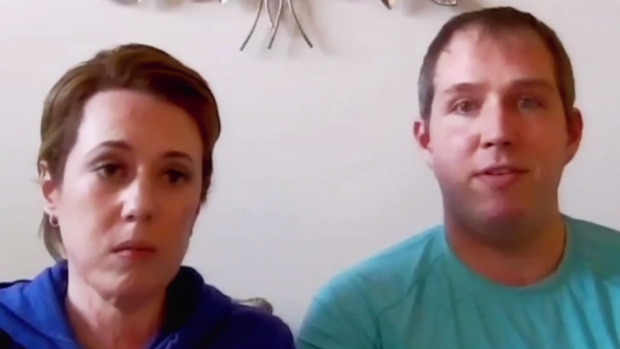
Last December 9, Matt and Lauren Urey took an excursion to the White Island volcano, snapping pictures near the crater. They were heading back to their boat when the volcano erupted. They heard the tour guide yell, "run," and in less than a minute, they were engulfed in scalding ash and smoke. They took cover behind a rock.
"It was just pitch black. You couldn't see anything in front of you, and you could just feel your skin burning, getting pelted with rocks. It was terrifying," Matt told "CBS This Morning" in June .
Matt said he and Lauren couldn't see each other.
"She was holding my wrist, but I had no idea other than that that she was there," he said. "I genuinely thought that was the end of my life, and I thought that was the end of Lauren's life."
Severely burned and barely breathing, Matt and Lauren found their way to a tour boat, which rushed them to the mainland. They ended up in hospitals 600 miles apart.
"The hospital that we originally were at ... couldn't handle all the burn victims," Lauren said, adding that Matt refused treatment until she was treated. "That's just the kind of person he is."
Both were put in medically induced comas and underwent skin grafts and plastic surgeries. It would be nearly two months before they were reunited back in the U.S.
- New Zealand
More from CBS News
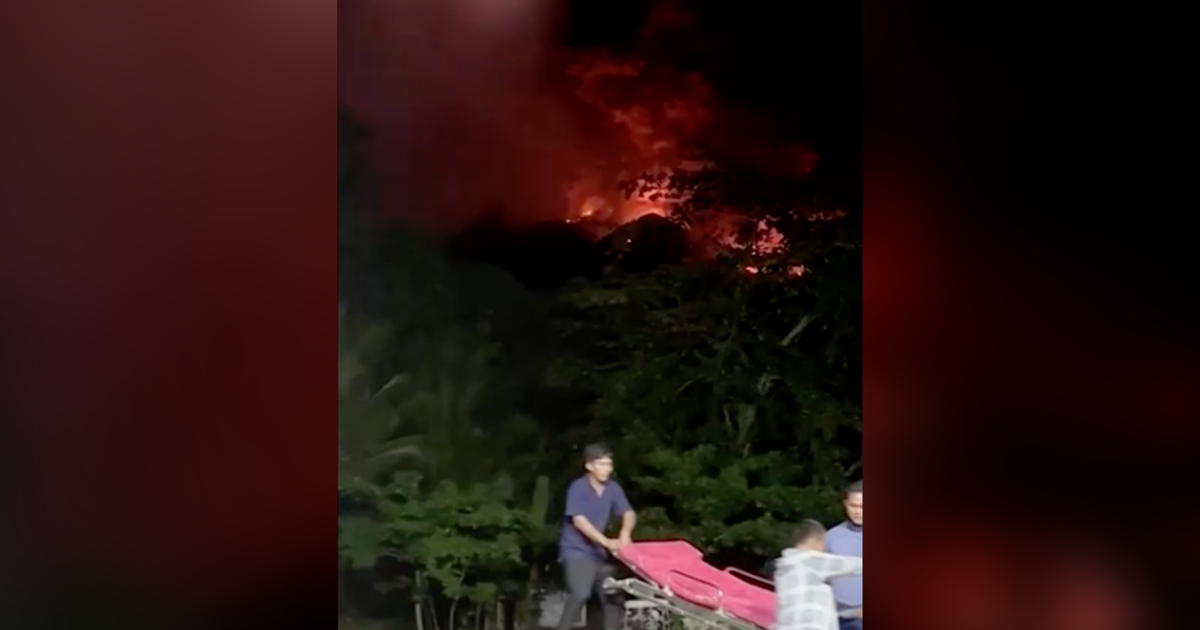
Indonesia volcano's days-long eruption forces hundreds to flee

Indonesia officials warn of potential tsunami amid volcano eruption
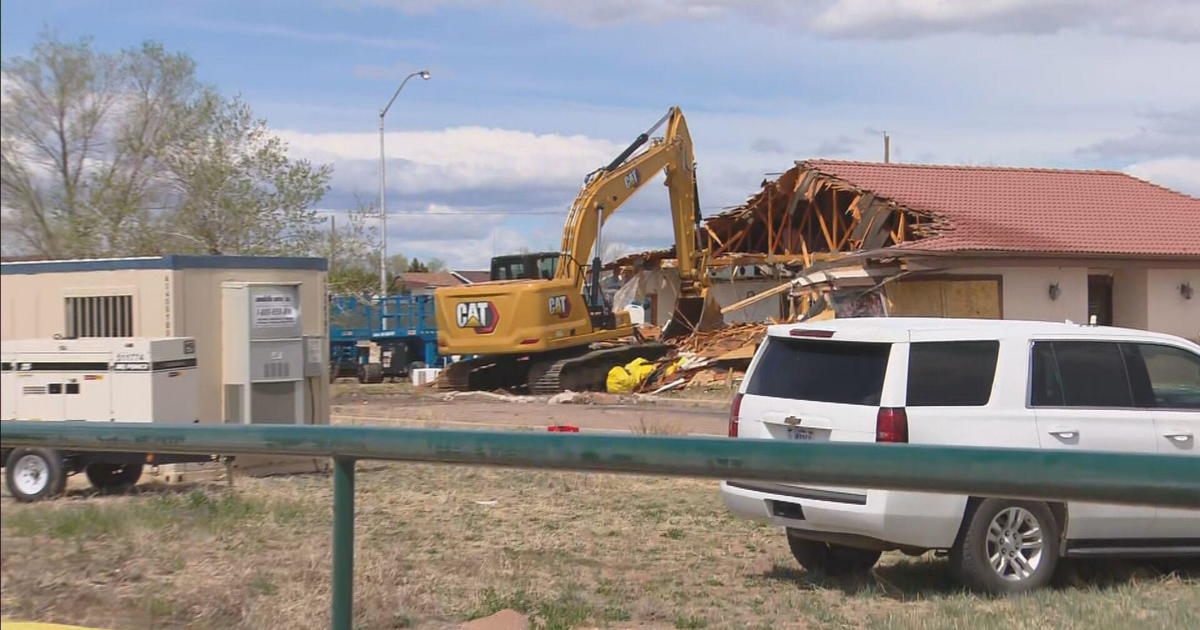
Owners of Colorado funeral home with decaying bodies face federal charges
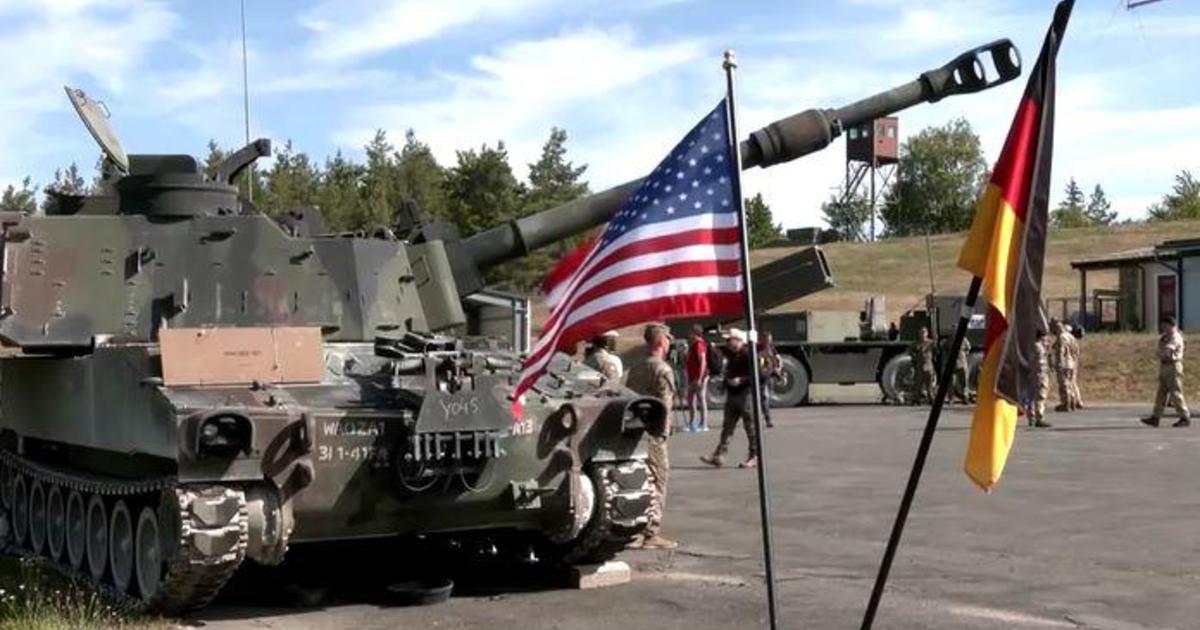
Germany arrests alleged Russian spies scouting U.S. military facilities
Whakaari White Island trial hears of excruciating choice survivor had to make in moments after eruption
The criminal trial into the Whakaari White Island disaster has heard evidence from an Australian survivor who lost both his parents and his only sister in the 2019 eruption.
Jesse Langford was 19 when he and his family were holidaying on Ovation of the Seas and took the volcano excursion.
A New Zealand court was played a video of Mr Langford's interview with police, in which he detailed the moment of the eruption, his painful walk away from the crater and the devastating decision he had to make to leave his family to go and seek help.
"My dad was sitting up, saying he was struggling to breathe, trying to rip off the gas mask," he said.
"My mum wasn't moving at all."
Mr Langford told police he knew he could not physically help anyone as he nursed his own severe burns, but made a decision to try and reach help and let first responders know there were still people alive near the crater lake.
"It still bothers me … making the decision to get up and walk away. It was a very difficult decision to make," he said in the police evidence interview.
"I pretty much just said my goodbyes as best I could."
The court heard the details of Mr Langford's desperate walk towards the wharf and the moments he had to stop to gather strength to carry on.
"I was having internal contemplation, like am I going to die here or am I going to keep on going? And I just found the will to get up and keep on walking," he said.
Mr Langford said at one point, he realised that if he stopped: "I probably wasn't going to have the strength to get up again, so I just made the decision to keep on walking and not stop until I get out."
He made it to Whakatane and was met by medical teams, who he begged for pain relief.
"They put the oxygen mask over my face. I was asleep after that for eight days and I woke up in Australia in ICU," Mr Langford said in the police interview.
It was then he learnt his family had not made it off the island alive.
The body of Jesse Langford's sister Winona has never been found.
Thirteen parties were originally charged with alleged breaches of New Zealand's workplace health and safety laws over the deadly disaster.
The trial began last week but in the lead-up, several defendants pleaded guilty, with only six now facing trial.
Those six defendants include Whakaari's private owners, Peter, Andrew and James Buttle, as well as their company Whakaari Management Limited.
The other two defendants are ID Tours New Zealand and Tauranga Tourism Services.
Jesse Langford said his family would often explore together and the Whakaari White Island visit seemed like the most interesting excursion to take from Ovation of Seas.
"As a family, we like doing all these adventurous things, especially my sister and I," he said.
Mr Langford said he would not have opted to be on the island had he understood the risk.
Whakaari was sitting at a level 2 volcanic warning on December 9. Level 3 is an eruption.
On day one of the trial, a Worksafe NZ lawyer told the court GNS Science had been drafting a bulletin warning of further increased volcanic activity, but the monitor never got a chance to issue the advice because the eruption happened.
"I didn't have any prior knowledge to what the island would even look like, except for what was on the [Royal Caribbean] website," he said.
Mr Langford said he would not have gone on the island had he understood more of the island's history and the risk of eruption.
The trial continues.
- X (formerly Twitter)
Related Stories
After she was covered in hot volcanic ash, travel blogger annie endured a horrifying journey to get help.
'At the time of the eruption, she just said run': Whakaari survivor recalls moment the volcano erupted
Three brothers own the NZ volcano that killed 17 Australians. Today their trial begins
- Courts and Trials
- Disasters, Accidents and Emergency Incidents
- New Zealand
Stay up to date with notifications from The Independent
Notifications can be managed in browser preferences.
UK Edition Change
- UK Politics
- News Videos
- Paris 2024 Olympics
- Rugby Union
- Sport Videos
- John Rentoul
- Mary Dejevsky
- Andrew Grice
- Sean O’Grady
- Photography
- Theatre & Dance
- Culture Videos
- Food & Drink
- Health & Families
- Royal Family
- Electric Vehicles
- Car Insurance deals
- Lifestyle Videos
- UK Hotel Reviews
- News & Advice
- Simon Calder
- Australia & New Zealand
- South America
- C. America & Caribbean
- Middle East
- Politics Explained
- News Analysis
- Today’s Edition
- Home & Garden
- Broadband deals
- Fashion & Beauty
- Travel & Outdoors
- Sports & Fitness
- Sustainable Living
- Climate Videos
- Solar Panels
- Behind The Headlines
- On The Ground
- Decomplicated
- You Ask The Questions
- Binge Watch
- Travel Smart
- Watch on your TV
- Crosswords & Puzzles
- Most Commented
- Newsletters
- Ask Me Anything
- Virtual Events
- Betting Sites
- Online Casinos
- Wine Offers
Thank you for registering
Please refresh the page or navigate to another page on the site to be automatically logged in Please refresh your browser to be logged in
‘It really, really hurt’: Four years after White Island volcano disaster court finds tour company guilty
New zealand judge pulls up tour operator for ‘astonishing failures’ related to safety audits, article bookmarked.
Find your bookmarks in your Independent Premium section, under my profile

For free real time breaking news alerts sent straight to your inbox sign up to our breaking news emails
Sign up to our free breaking news emails, thanks for signing up to the breaking news email.
In 2019, a group of people, including honeymooners, took a tour of the active Whakaari White Island volcano in New Zealand, excited about the adventure they were about to embark on.
However, their thrill soon turned into horror and a life of searing pain, suffering and loss as the volcano erupted, killing 22 people and severely injuring dozens of others.
A New Zealand court on Tuesday found a tour company guilty of violating workplace safety laws during the 2019 Whakaari White Island volcano disaster.
Whakaari Management Limited (WML), a holding company owned by the landowners of White Island, was denounced by judge Evangelos Thomas on Tuesday for conducting a tour of the volcano as it erupted.
The judge pulled up the company for “astonishing failures” related to safety audits, given the “obvious risks”.
“Screams for help and screams in agony,” American tourist Lauren Urey said in her testimony.
WML was convicted for the violation of workplace safety laws, but a second charge was dismissed. The conviction ended what was the largest action against a company introduced by Worksafe NZ, the country’s workplace safety regulator.
The families that included 17 Australians, three Americans, and two New Zealanders were visiting the island, also known by its traditional Māori name Whakaari.
Tragedy soon struck after the volcano erupted and led to 22 people being killed and 25 others left with severe burns in one of New Zealand’s worst natural disasters.
The people were present on the east coast island where a tour organised by the company included ferrying them near the country’s most active volcano for a closeup look.
“The expert evidence... was also common sense,” judge Thomas observed in the latest ruling.
“In WML’s case, it should have appreciated that it could [not] rely on risk assessment work being done by others to relieve it of its own obligation in relation to risk... it needed to stop and re-evaluate,” he said.
Legal representatives for WML argued that the company was a landowner and did not have direct oversight of island tours and their operations.
But judge Thomas said the company managed and controlled the volcano and did not fulfil its duty to minimise risks for tourists.
“It should have been no surprise that Whakaari could erupt at any time, and without warning, at the risk of death and serious injury,” he said.
A second charge related to the safety of WML’s own workers was dismissed.
The company now faces a maximum fine of NZ$1.5m (£724,000), with a sentence against guilty defendants to be announced next year.
Six other defendants pleaded guilty to health and safety failings. Their sentencing is due in February 2024. Six others had their charges dismissed.
In the aftermath of the eruption, 13 parties had been implicated.
They included the owners of WML – James, Andrew and Peter Buttle – the three brothers who inherited ownership of the volcano and other businesses. The Buttle brothers were on trial over charges related to breaching the country’s safety regulations, but they were dismissed last month.
WML, tour operator White Island Tours, various other tourism firms and New Zealand’s volcano monitoring agency, the GNS Science and the National Emergency Management Agency, were also charged.
The eruption triggered a debate over safety regulations in New Zealand’s adventure tourism industry.
The trial that opened in July this year featured vivid, emotional testimonies from numerous survivors who said they were inadequately informed about the risks associated with the Whakaari volcano.
The survivors described being dumbfounded by the eruption. They first saw a silently billowing black cloud and were soon lashed by molten sand, ash and burning rocks hurtling towards them.
Brazilian tourist Allessandro Kauffmann recorded the horrific moments of the eruption on Whakaari that later went viral.
They showed a huge mushroom cloud unfurling on the horizon that swiftly engulfed the island, followed by a dark, fast-moving avalanche of rock, ash and acidic gas.
The sheer force of the event was staggering, as described by Mr Kauffmann’s wife Aline, who referred to the smoke as “massive” and approaching rapidly, according to Outside Magazine .
Paul Kingi, crewing on the ship Phoenix , witnessed the eruption debris dropping down into the sea and hurtling toward his ship. He shouted at everyone to get inside. Chaos ensued as the ship’s captain swiftly steered southward and executed a sweeping manoeuvre to escape the eruption.
People aboard another ship in Crater Bay, the Te Puia Whakaari , were not so lucky. Its captain David Plews was anchored directly in the path of the high-speed, 60-mile-per-hour gas and rock tsunami.
The 42 passengers in his ship were either already engulfed by the chaos or were on the verge of being so.
Some of the people jumped into the water while others were not able to make it in time. American tourists Matthew and Lauren Urey, who were there for their honeymoon, said the sea was choppy that day and passengers were not informed of any dangers.
“I remember somebody yelling, ‘look’ and I looked over and I saw a very large black cloud coming out of the volcano. And that’s when we were told to run,” Ms Urey, who had reached the edge of crater with their group and were returning back to boat, told CNN.
She described the billowing black cloud as eerily quiet, but as she and her husband took cover behind a rock, they suddenly heard a resounding explosion as the volcano erupted, followed by harrowing cries.
“Screams for help and screams in agony,” she said in her testimony.
Her husband said he struggled to breathe as they were surrounded by waves of heat that experts estimated reached 100C or more.
The couple has since then undergone multiple surgeries and skin grafts. They have also put plans to have babies on hold as Ms Urey is considered high risk.
Jesse Langford, a 19-year-old from Sydney, had gone to the family trip with his mother, father and sister, but returned alone with severe burns. He said he was admitted to the hospital and was in a coma for eight days.
“I was being hammered by this sandstorm like in the movies where you can’t see two metres in front of you. I was in so much pain,” he said.
When the skies cleared, he said everything was covered in grey ash. He saw his father sitting up and struggling to breathe and his mother was not moving at all. His teenage sister’s body was never found.
Australian tourist Anne Lou was left with 38 per cent of body covered in burns. “There were no clear instructions or plan, everybody just purely went on fight-or-flight instinct and ran directly for the jetty,” she said.
She said she felt the moment was “like sand and rocks everywhere” that were hurtling towards them.
“It really, really hurt,” she said.
“It was just burning. I’ve never felt anything like that before. It was just like someone heated up some needles until it was iron hot and then shoving it all onto you.”
Join our commenting forum
Join thought-provoking conversations, follow other Independent readers and see their replies
Subscribe to Independent Premium to bookmark this article
Want to bookmark your favourite articles and stories to read or reference later? Start your Independent Premium subscription today.
New to The Independent?
Or if you would prefer:
Want an ad-free experience?
Hi {{indy.fullName}}
- My Independent Premium
- Account details
- Help centre
- Share full article
For more audio journalism and storytelling, download New York Times Audio , a new iOS app available for news subscribers.
The Opening Days of Trump’s First Criminal Trial
Here’s what has happened so far in the unprecedented proceedings against a former u.s. president..
This transcript was created using speech recognition software. While it has been reviewed by human transcribers, it may contain errors. Please review the episode audio before quoting from this transcript and email [email protected] with any questions.
It’s the first day of the Trump trial and just walking out the door in my house. It’s a beautiful day, 6:11 AM. The thing that keeps running through my head is it’s kind of amazing that hundreds of jurors are going to show up at the Manhattan courthouse. And some of them are going to know what they’re there for — probably talking to their friends, their relatives about it.
Some of them are going to learn this morning talking to other jurors in line, asking what all the fuss is about. But I really do imagine that there’s going to be at least one potential juror who, headphones on, getting into court. Here they’re going to be there for the first criminal trial of Donald J. Trump. And just, I mean, how would you react?
[MUSIC PLAYING]
From “The New York Times,” I’m Michael Barbaro. This is “The Daily.” Today, what it’s been like inside the lower Manhattan courtroom, where political and legal history are being made? My colleague, Jonah Bromwich, on the opening days of the first criminal trial of a US President. It’s Thursday, April 18.
Is that his mic? Hi, there.
Hello. How are you?
I’m doing good.
OK. Thank you for coming in, Jonah —
Thank you for having me.
— in the middle of a trial. Can you just explain why you’re able to even be here?
Sure. So we happen to be off on Wednesdays during trial, so.
We being not “The New York Times,” but the courts.
That’s right.
Which is why we’re taping with you. And because we now have two full court days of this history-making trial now under our belts. And the thing about this trial that’s so interesting is that there are no cameras in the courtroom for the wider world.
There’s no audio recordings. So all we really have is and your eyes and your notebook, maybe your laptop. And so we’re hoping you can reconstruct for us the scene of the first two days of this trial and really the highlights.
Yeah, I’d be happy to. So on Monday morning, I left the subway. It’s before 7:00 AM. The sun is just rising over these grandiose court buildings in lower Manhattan.
I’m about to turn left onto Center Street. I’m right in front of the big municipal building.
And I turn onto Center Street. That’s where the courthouses are.
I’m crossing.
And I expected to see a big crowd. And it was even bigger than I had anticipated.
Here we go. Here we go. Here we go. Now, I finally see the crowd.
You have camera banks. You have reporters. You have the beginnings of what will eventually become a protest. And you have this most New York thing, which is just a big crowd of people.
[CHUCKLES]: Who just know something is going on.
That’s right. And what they know is going on is, of course, the first trial of an American president.
All right, I’m passing the camera, folks. Camera, camera, camera, camera. Here we go.
Let’s start with Sharon Crowley live outside the courthouse in Lower Manhattan.
I want to get right to ABC’S Aaron Katersky who’s outside of the courthouse.
Robert Costa is following it outside the courthouse in Lower Manhattan. Bob, I saw the satellite trucks lined up all in a row. Good morning.
Talk to us how we got here exactly.
So this is the case that was brought by the Manhattan district attorney. So prosecutors have accused Donald Trump of covering up the actions of his former fixer, Michael Cohen, after Cohen paid hush money to Stormy Daniels. Stormy Daniels had a story about having had sex with Donald Trump, which Trump has always denied.
Cohen paid her money, and then Trump reimbursed Cohen. And prosecutors say that Trump essentially defrauded the American people because he hid this information that could have been very important for the election from those people when he reimbursed Cohen.
Right. And as I remember it, he also misrepresented what that reimbursement was. Claimed it was a legal fee when, in fact, it was just reimbursing Michael Cohen for a hush money payment.
Exactly, yeah. He definitely didn’t say reimbursement for hush money payment to Stormy Daniels. It’s a cover up case. It’s a case about hiding information you don’t want people to see.
Right. And of course, the context of all this is that it is in the middle of a presidential election. It’s 2016. Trump wants to keep this secret, prosecutors allege, so that the American public doesn’t know about it and potentially hold it against him.
Right. And prosecutors are telling a story about election interference. They’re saying that Trump interfered with an election. And Trump himself is also using the phrase “election interference.” But he’s painting the trial itself as election interference as he now runs again in 2024.
Fascinating.
And because we’re in Manhattan, and because the jury pool is going to be largely Democratic, and the judge is a Democrat, and the district attorney is a Democrat, Trump keeps claiming he cannot get a fair shake. This is democrat central. And in democrat central, Trump doesn’t have a chance.
OK. So, what happens once you actually enter the courthouse?
Outside, there’s all this fanfare. But inside, it’s a little bit business as usual. So I go up to the 15th floor, and I walk into the courtroom, and I sit down, and it’s the same old courtroom. And we’re sitting and waiting for the former president.
Around 9:30, Trump walks in. He looks thin. He looks a little tired, kind of slumping forward, as if to say with his body like let’s get this over with. Here we go.
The judge walks in a little bit after that. And we think we’re all set for the trial to start, but that’s not what happens here. And in fact, there are a series of legal arguments about what the trial is going to look like and what evidence is going to be allowed in.
So, for example, prosecutors ask that they be allowed to admit into evidence headlines from “The National Enquirer” that were attacks on Trump’s 2016 opponents — on Ted Cruz, on Marco Rubio, on Ben Carson.
Because prosecutors are in some sense putting Trump’s 2016 campaign on trial. These headlines are a big part of that because what prosecutors say they show is that Trump had this ongoing deal with “The National Enquirer.” And the publisher would promote him, and it would publish damaging stories about his opponents. And then crucially, it would protect Trump from negative stories. And that’s exactly what prosecutors say happened with Stormy Daniels. That “The National Enquirer” tipped Cohen off about Stormy Daniels trying to sell her story of having had sex with Donald Trump, which he denies. And that led to the hush money payment to her. So what prosecutors are doing overall with these headlines is establishing a pattern of conduct. And that conduct, they say, was an attempt to influence the election in Trump’s favor.
And the judge agrees. He’s going to admit this evidence. And this is a pretty big win for the prosecution. But even though they win that one, they’re not winning everything.
They lose some important arguments here. One of them was that after the Access Hollywood tape came out, there were allegations of sexual assault against Donald Trump. And you know this, Michael, because you reported two of them — two of the three in question at this very trial.
Prosecutors had hoped to talk about those during trial in front of the jury to show the jurors that the Trump campaign was really, really focused on pushing back against bad press in the wake of the Access Hollywood tape in which Trump seemed to describe sexual assault. That was a big problem for the campaign. Campaign did everything it could to push back, including against these allegations that surfaced in the wake of the tape.
But the judge, saying that the allegations are hearsay — that they’re based on the women’s stories — says absolutely not. That is incredibly prejudicial to the defendant.
Interesting.
And that Donald Trump would actually not get a fair trial were those allegations to be mentioned. And so he will not let those in. The jurors will not hear about them.
So this is a setback, of course, for the prosecution, a victory for Trump’s legal team.
It’s a setback. And it also just shows you how these pre-trial motions shape the context of the trial. Think of the trial as a venue like a theater or an athletic contest of some sort. And these pre-trial motions are about what gets led into the arena and what stays out. The sexual assault allegations — out. “The National Enquirer” headlines — in.
OK. And how is Trump sitting there at the defense table reacting to these pre-trial motion rulings from the judge?
Well, as I’ve just said, this is very important stuff for his trial.
Right. Hugely important.
But it’s all happening in legal language, and I’m decoding it for you. But if you were sitting there listening to it, you might get a little lost, and you might get a little bored. And Trump, who is not involved in these arguments, seems to fall asleep.
Seems to fall asleep — you’re seeing this with your own eyes.
What we’re seeing, overall, including our colleague, Maggie Haberman, who’s in the overflow room and has a direct view of Trump’s face — I’m sitting behind him in the courtroom, so I can’t see his face that well.
You guys are double teaming this.
That’s right. I’m sitting behind him, but Maggie is sitting in front of him. And what she sees is not only that his eyes are closed. That wouldn’t get you to he is asleep.
And we have to be really careful about reporting that he’s asleep, even if it seems like a frivolous thing. But what happens is that his head is dropping down to his chest, and then it’s snapping back up. So you’ve seen that, when a student —
I’ve done that.
(CHUCKLES) Yeah. We all kind of know that feeling of snapping awake suddenly. And we see the head motion, and it happens several times.
Lawyers kind of bothering him, not quite shaking him, but certainly trying to get his attention. And that head snapping motion, we felt confident enough to report that Trump fell asleep.
During his own criminal trial’s opening day.
Does someone eventually wake him up?
He wakes up. He wakes up. And in fact, in the afternoon, he’s much more animated. It’s almost as if he wants to be seen being very much awake.
Right. So once these pre-trial motions are ruled on and Trump is snapped back to attention, what happens?
Well, what happens in the courtroom is that the trial begins. The first trial of an American president is now in session. And what marks that beginning is jurors walking into the room one by one — many of them kind of craning their necks over at Donald Trump, giggling, raising their eyebrows at each other, filing into the room, and being sworn in by the judge. And that swearing in marks the official beginning of the trial.
The beginning is jury selection, and it’s often overlooked. It’s not dramatized in our kind of courtroom dramas in the same way. But it’s so important. It’s one of the most important parts of the case. Because whoever sits on the jury, these are the 12 people who are going to decide whether Trump is guilty or whether Trump is innocent.
So how does jury selection actually look and feel and go?
So, jury selection is a winnowing process. And in order to do that, you have to have these people go through a bunch of different hurdles. So the first hurdle is, after the judge describes the case, he asks the group — and there are just short of 100 of them — whether they can be fair and impartial. And says that if they can’t, they should leave. And more than half the group is instantly gone.
So after we do this big mass excusal, we’re left with the smaller group. And so now, jurors are getting called in smaller groups to the jury box. And what they’re going to do there is they’re going to answer this questionnaire.
And this part of the process is really conducted by the judge. The lawyers are involved. They’re listening, but they’re not yet asking questions of the jurors themselves.
And what’s on the questionnaire?
Well, it’s 42 questions. And the questions include, their education, their professional histories, their hobbies, what they like to do whether you’re a member of QAnon or Antifa.
Whether you’re far left or far right.
That’s right. Whether you’ve read “The Art of the Deal,” Trump’s book, which some prospective jurors had.
Right. It was a bestseller in its time.
That’s right. And some of it can be answered in yes/no questions, but some of it can be answered more at length. So some of the prospective jurors are going very, very fast. Yes, no, no, no, yes.
Right. Because this is an oral questionnaire.
That’s right. But some of them are taking their time. They’re expanding on their hobbies. So the potential juror in seat 3, for example, is talking about her hobbies. And she says some running, hiking. And then she said, I like to go to the club, and it got a huge laugh. And you get that kind of thing in jury selection, which is one of the reasons it’s so fun. It’s the height of normality in this situation that is anything but normal.
Right. The most banal answer possible delivered in front of the former president And current Republican nominee for president.
Well, that’s one of the fascinating parts about all this, right? is that they’re answering in front of Trump. And they’re answering questions about Trump in front of Trump. He doesn’t react all that much. But whenever someone says they’ve read “The Art of the Deal —” and there are a few of those — he kind of nods appreciatively, smiles. He likes that. It’s very clear. But because there are so many questions, this is taking forever, especially when people are choosing to answer and elaborate and digress.
This is when you fall asleep.
This Is. When I would have fallen asleep if I were a normal person.
And by the end of the day. Where does jury selection stand?
Well, the questionnaire is another device for shrinking that jury pool. And so the questionnaire has almost these little obstacles or roadblocks, including, in fact, a question that jurors have seen before — whether they would have any problem being fair and impartial?
Hmm. And they ask it again.
They’re asked it again. And they’re asked in this more individualized way. The judge is questioning them. They’re responding.
So, remember that woman who said she liked to go to the club got a big laugh. She reaches question 34. And question 34 reads, “Do you have any strong opinions or firmly-held beliefs about former President Donald Trump or the fact that he is a current candidate for president that would interfere with your ability to be a fair and impartial juror?” She said, yes, she does have an opinion that would prevent her from being fair and impartial. And she, too, is excused.
So that’s how it works. People answer the questionnaire, and they get excused in that way, or they have a scheduling conflict once they reach the jury box. And so to answer your question, Michael. At the end of day one, given all these problems with the questionnaire and the length of time it’s taken to respond to and people getting dismissed based on their answers, there is not a single juror seated for this trial.
And it’s starting to look like this is going to be a really hard case for which to find an impartial jury.
That’s the feeling in the room, yeah.
We’ll be right back.
So Jonah, let’s turn to day 2. What does jury selection look like on Tuesday?
So when the day begins, it looks almost exactly like it looked when the day ended on Monday. We’re still with the questionnaire, getting some interesting answers. But even though it feels like we’re going slow, we are going.
And so we’ve gone from about 100 people to now there’s about 24 the room there’s 18 the jury box. And by the time we hit lunch, all those people have answered all those questions, and we are ready for the next step in the process.
Voir dire. And what it is the heart of jury selection. This is the point where the lawyers themselves finally get to interview the jurors. And we get so much information from this moment because the lawyers ask questions based on what they want out of the jurors.
So the prosecution is asking all these different kinds of questions. The first round of wajir is done by a guy named Joshua Steinglass, a very experienced trial lawyer with the Manhattan District Attorney’s Office. And he’s providing all these hypotheticals. I’ll give you one example because I found this one really, really interesting. He provides a hypothetical about a man who wants his wife killed and essentially hires a hitman to do it. And what he asked the jurors is, if that case were before you, would you be able to see that the man who hired the hitman was a part of this crime?
And of course, what he’s really getting at is, can you accept that even though Michael Cohen, Trump’s fixer, made this payment, Trump is the guy who hired him to do it?
That’s right. If there are other people involved, will jurors still be able to see Donald Trump’s hands behind it all?
Fascinating. And what were some of the responses?
People mostly said, yes, we accept that. So that’s how the prosecution did it.
But the defense had a totally different method of voir dire. They were very focused on their client and people’s opinions about their client.
So what kind of questions do we get from them?
So the lawyer, Todd Blanche, is asking people, what do you make of President Trump? What do you think of President Trump?
And what are some of the responses to that?
Well, there’s this incredible exchange with one of the jurors who absolutely refuses to give his opinion of Donald Trump. They go back and forth and back and forth. And the juror keeps insisting you don’t need to know my opinion of him. All you need to know is that I’m going to be fair and impartial, like I said. And Blanch pushes, and the guy pushes back. And the only way the guy budges is he finally kind of confesses almost at the end that, yes, I am a Democrat, and that’s all we get.
And what ends up happening to this potential juror?
Believe it or not, he got dismissed.
[LAUGHS]: I can believe it. And of course, it’s worth saying that this guy and everybody else is being asked that question just feet from Trump himself.
That’s right. And you might think you were going to get a really kind of spicy, like, popcorn emoji-type exchange from that. But because these are now jurors who have said they can be fair and impartial, who, to some extent, want to be on this jury or at least wouldn’t mind being on this jury, they’re being very restrained.
Mostly, what they are emphasizing — much like that guy just described dis — is that they can be fair. They can be impartial. There’s one woman who gives this really remarkable answer.
She says, I thought about this last night. I stayed up all night. I couldn’t sleep, thinking about whether I could be fair. It’s really important to me, and I can.
What ends up happening to that particular juror?
She’s also dismissed. And she’s dismissed without any reason at all. The defense decides it doesn’t like her. It doesn’t want her on the jury. And they have a certain number of chances to just get rid of jurors — no questions asked.
Other jurors are getting dismissed for cause — I’m doing air quotes with my hands — which means that the lawyers have argued they actually revealed themselves through their answers or through old social media posts, which are brought up in the courtroom, to be either non-credible, meaning they’ve said they can be fair and they can’t, or somehow too biased to be on the jury.
Wait, can I just dial into that for a second? Are lawyers researching the jurors in real time going online and saying — I’m making this up — but Jonah Bromwich is a potential juror, and I’m going to go off into my little corner of the courtroom and Google everything you’ve ever said? Is that what’s happening in the room?
Yeah, there’s a whole profession dedicated to that. It’s called jury consultant, and they’re very good at finding information on people in a hurry. And it certainly looked as if they were in play.
Did a social media post end up getting anybody kicked off this jury?
Yes, there were posts from 2016 era internet. You’ll remember that time as a very heated one on the internet, Facebook memes are a big thing. And so there’s all kinds of lock him up type memes and rhetoric. And some of the potential jurors here have used those. And those jurors are dismissed for a reason.
So we have these two types of dismissals, right? We have these peremptory dismissals — no reason at all given. And we have for cause dismissals.
And the process is called jury selection. But you don’t actually get selected for a jury. The thing is to make it through all these obstacles.
You’re left over.
Right. And so when certain jurors are not dismissed, and they’ve made it through all these stages, by the end of the day, we have gone from zero juror seated to seven jurors who will be participating in Donald Trump’s trial.
Got it. And without going through all seven, just give us a little bit of a sketch of who so far is on this jury. What stands out?
Well, not that much stands out. So we’ve got four men. We’ve got three women. One lives on the Upper East Side. One lives in Chelsea. Obviously, they’re from all over Manhattan.
They have these kind of very normal hobbies like spending time with family and friends. They have somewhat anonymous jobs. We’ve got two lawyers. We’ve got someone who’s worked in sales.
So there’s not that much identifying information. And that’s not an accident . One of the things that often happens with jury selection, whether it be for Donald Trump or for anyone else, is the most interesting jurors — the jurors that kind of catch your attention during the process — they get picked off because they are being so interesting that they interest one or the other side in a negative way. And soon they’re excused. So most of the jurors who are actually seated —
Are not memorable.
Are not that memorable, save one particular juror.
OK. All right, I’ll bite. What do I need to know about that one particular juror?
So let me tell you about a prospective juror who we knew as 374, who will now be juror number five. She’s a middle school teacher from Harlem. And she said that she has friends who have really strong opinions about Trump, but she herself does not. And she insisted several times, I am not a political person.
And then she said this thing that made me quite surprised that the prosecution was fine with having her on the jury. She said, quote, “President Trump speaks his mind, and I’d rather that than someone who’s in office who you don’t know what they’re thinking.”
Hmm. So she expressed approval of President Trump.
Yeah, it was mild approval. But the thing is, especially for the defense in this trial, all you need is one juror. One juror can tie up deliberations in knots, and you can end with a hung jury. And this is actually something that I saw firsthand. In 2019, I was the foreperson on a jury.
How you like that?
Yeah. And the trial was really complicated, but I had thought while we were doing the trial, oh, this is going to be a really easy decision. I thought the defendant in that case was guilty. So we get into deliberations, but there’s this one juror who keeps gumming up the works every time we seem to be making progress, getting a conversation started.
This juror proverbially throws up his hands and says, I am not convicting. This man is innocent. And we talked and we talked. And as the foreperson, I was trying to use all my skills to mediate.
But any time we made any progress, this guy would blow it up. And long story short, hung jury — big victory for the defense lawyer. And we come out of the room. And she points at this juror. The guy —
The defense lawyer.
The defense lawyer points at this juror who blew everything up. And she said, I knew it. I knew I had my guy.
OK. I don’t want to read too much into what you said about that one juror. But should I read between the lines to think that if there’s a hung jury, you wonder if it might be that juror?
That’s what everyone in the courtroom is wondering not just about this juror, but about every single person who was selected. Is this the person who swings the case for me? Is this the person who swings the case against me?
These juries are so complex. It’s 12 people who don’t know each other at the start of the trial and, by the end of the trial, have seen each other every morning and are experiencing the same things, but are not allowed to have talked about the case until deliberations start. In that moment when deliberations start —
You’re going to learn a whole lot about each other.
That’s right. There’s this alchemical moment where suddenly, it all matters. Every personality selected matters. And that’s why jury selection is so important. And that’s why these last two days are actually one of the most important parts of this trial.
OK. So by my math, this trial will require five more jurors to get to 12. I know also they’re going to need to be alternates. But from what you’re saying what looked like a really uphill battle to get an impartial jury or a jury that said it could be impartial — and Trump was very doubtful one could be found — has turned out to not be so hard to find.
That’s right. And in fact, we went from thinking, oh, boy, this is going awfully slowly, to the judge himself saying we could be doing opening arguments as soon as Monday morning. And I think that highlights something that’s really fascinating both about this trial and about the jury selection process overall.
One of the things that lawyers have been arguing about is whether or not it’s important to figure out what jurors’ opinions about Donald Trump are. And the prosecution and, I think, the judge have really said, no, that’s not the key issue here. The key issue is not whether or not people have opinions about Donald Trump.
Right. Who doesn’t have an opinion about Donald Trump?
Exactly. They’re going to. Automatically, they’re going to. The question is whether or not they can be fair and impartial. And the seven people we already have seated, and presumably the five people that we’re going to get over the next few days and however many alternates — we expect six — are all going to have answered that question, not I hate Trump; I love Trump, but I can weigh in on the former president’s innocence or guilt, and I can do it as fairly as humanly possible.
Now, Trump is not happy about this. He said after court yesterday, quote, We have a highly conflicted judge, and he’s rushing this trial.” And I think that he is going to see these beats of the system the criminal justice system as it works on him as he is experiencing it as unfair. That is typically how he talks about it and how he views it.
But what he’s getting is what defendants get. This is the system in New York, in the United States. This is its answer to how do you pick a fair jury? Well, you ask people can you be fair? And you put them through this process, and the outcome is 12 people.
And so I think we’re going to see this over and over again in this trial. We’re going to see Trump experience the criminal justice system.
And its routines.
Yeah, openings, witnesses, evidence, closings. He’s going to go through all of it. And I think, at every turn, it makes sense to expect him to say, well, this is not fair. Well, the judge is doing something wrong. Well, the prosecutors are doing something wrong. Well, the jury is doing something wrong.
But at the end of the day, he’s going to be a defendant, and he’s going to sit, mostly silently if his lawyers can make him do that, and watch this process play itself out. So the system is going to try and treat him like any other defendant, even though, of course —
— he’s not. And he is going to fight back like no other defendant would, like no other defendant could. And that tension, him pushing against the criminal justice system as it strives to treat him, as it would anyone else, is going to be a defining quality of this trial.
Well, Jonah, thank you very much. We appreciate it.
Of course. Thanks so much for having me. [MUSIC PLAYING]
PS, have you ever fallen asleep in a trial?
I have not.
[CHUCKLES]:
Here’s what else you need to know today.
It’s clear the Israelis are making a decision to act. We hope they do so in a way that does as little to escalate this as possible and in a way that, as I said —
During a visit to Jerusalem on Wednesday, Britain’s foreign Secretary left little doubt that Israel would retaliate against Iran for last weekend’s aerial attack, despite pressure from the United States and Britain to stand down. The question now is what form that retaliation will take? “The Times” reports that Israel is weighing several options, including a direct strike on Iran, a cyber attack, or targeted assassinations. And —
Look, history judges us for what we do. This is a critical time right now, critical time on the world stage.
In a plan that could threaten his job, Republican House Speaker Mike Johnson will put a series of foreign aid bills up for a vote this weekend. The bills, especially for aid to Ukraine, are strongly opposed by far-right House Republicans, at least two of whom have threatened to try to oust Johnson over the plan.
I can make a selfish decision and do something that’s different, but I’m doing here what I believe to be the right thing. I think providing lethal aid to Ukraine right now is critically important. I really do. I really — [MUSIC PLAYING]
Today’s episode was produced by Rikki Novetsky, Will Reid, Lynsea Garrison, and Rob Zubko. It was edited by Paige Cowett, contains original music by Marion Lozano, Elisheba Ittoop, and Dan Powell, and was engineered by Chris Wood. Our theme music is by Jim Brunberg and Ben Landsverk of Wonderly Lake.
That’s it for “The Daily.” I’m Michael Barbaro. See you tomorrow.

- April 19, 2024 • 30:42 The Supreme Court Takes Up Homelessness
- April 18, 2024 • 30:07 The Opening Days of Trump’s First Criminal Trial
- April 17, 2024 • 24:52 Are ‘Forever Chemicals’ a Forever Problem?
- April 16, 2024 • 29:29 A.I.’s Original Sin
- April 15, 2024 • 24:07 Iran’s Unprecedented Attack on Israel
- April 14, 2024 • 46:17 The Sunday Read: ‘What I Saw Working at The National Enquirer During Donald Trump’s Rise’
- April 12, 2024 • 34:23 How One Family Lost $900,000 in a Timeshare Scam
- April 11, 2024 • 28:39 The Staggering Success of Trump’s Trial Delay Tactics
- April 10, 2024 • 22:49 Trump’s Abortion Dilemma
- April 9, 2024 • 30:48 How Tesla Planted the Seeds for Its Own Potential Downfall
- April 8, 2024 • 30:28 The Eclipse Chaser
- April 7, 2024 The Sunday Read: ‘What Deathbed Visions Teach Us About Living’
Hosted by Michael Barbaro
Featuring Jonah E. Bromwich
Produced by Rikki Novetsky , Will Reid , Lynsea Garrison and Rob Szypko
Edited by Paige Cowett
Original music by Dan Powell , Marion Lozano and Elisheba Ittoop
Engineered by Chris Wood
Listen and follow The Daily Apple Podcasts | Spotify | Amazon Music
Political and legal history are being made in a Lower Manhattan courtroom as Donald J. Trump becomes the first former U.S. president to undergo a criminal trial.
Jonah Bromwich, who covers criminal justice in New York, explains what happened during the opening days of the trial, which is tied to Mr. Trump’s role in a hush-money payment to a porn star.
On today’s episode

Jonah E. Bromwich , who covers criminal justice in New York for The New York Times.

Background reading
Here’s a recap of the courtroom proceedings so far.
Mr. Trump’s trial enters its third day with seven jurors chosen.
There are a lot of ways to listen to The Daily. Here’s how.
We aim to make transcripts available the next workday after an episode’s publication. You can find them at the top of the page.
The Daily is made by Rachel Quester, Lynsea Garrison, Clare Toeniskoetter, Paige Cowett, Michael Simon Johnson, Brad Fisher, Chris Wood, Jessica Cheung, Stella Tan, Alexandra Leigh Young, Lisa Chow, Eric Krupke, Marc Georges, Luke Vander Ploeg, M.J. Davis Lin, Dan Powell, Sydney Harper, Mike Benoist, Liz O. Baylen, Asthaa Chaturvedi, Rachelle Bonja, Diana Nguyen, Marion Lozano, Corey Schreppel, Rob Szypko, Elisheba Ittoop, Mooj Zadie, Patricia Willens, Rowan Niemisto, Jody Becker, Rikki Novetsky, John Ketchum, Nina Feldman, Will Reid, Carlos Prieto, Ben Calhoun, Susan Lee, Lexie Diao, Mary Wilson, Alex Stern, Dan Farrell, Sophia Lanman, Shannon Lin, Diane Wong, Devon Taylor, Alyssa Moxley, Summer Thomad, Olivia Natt, Daniel Ramirez and Brendan Klinkenberg.
Our theme music is by Jim Brunberg and Ben Landsverk of Wonderly. Special thanks to Sam Dolnick, Paula Szuchman, Lisa Tobin, Larissa Anderson, Julia Simon, Sofia Milan, Mahima Chablani, Elizabeth Davis-Moorer, Jeffrey Miranda, Renan Borelli, Maddy Masiello, Isabella Anderson and Nina Lassam.
Jonah E. Bromwich covers criminal justice in New York, with a focus on the Manhattan district attorney’s office and state criminal courts in Manhattan. More about Jonah E. Bromwich
Advertisement
- International edition
- Australia edition
- Europe edition

Dubai floods: Chaos, queues and submerged cars after UAE hit by record rains
Passengers report being stranded in the desert city as the international hub struggles in the wake of unusually heavy rain
Don’t blame cloud seeding for the Dubai floods
Dubai is wrestling with the aftermath of extraordinary torrential rains that flooded the desert city, with people describing harrowing stories of spending the night in their cars, and air passengers enduring chaotic scenes at airports.
Up to 259.5mm (10.2in) of rain fell on the usually arid country of the United Arab Emirates on Tuesday, the most since records began 75 years ago . The state-run WAM news agency called the rains on Tuesday “a historic weather event” that surpassed “anything documented since the start of data collection in 1949”.
As the sun returned on Wednesday, along with it came stories of people stuck in cars and offices through an arduous night.
“It was one of the most horrific situations I had ever experienced,” said one Dubai resident in his 30s, who did not want to give his name, after his 15-minute commute turned into a 12-hour ordeal on flooded roads.

At Dubai’s airport, one of the busiest for international travel, with nearly every flight repeatedly delayed, Emirates passengers were told to stay away “unless absolutely necessary”.
Frustration from those already there began to build.
A large crowd formed at a connections desk, clapping and whistling in protest as they waited for information.
“They are completely lost, it’s complete chaos – no information, nothing,” fumed one passenger, who did not want to be named, after a 12-hour wait, Agence France-Presse reported.
Standing water lapped on taxiways as aircraft landed. One couple called the situation “absolute carnage”. They spoke to the Associated Press on condition of anonymity in order to speak freely in a country with strict laws that criminalise critical speech. “You cannot get a taxi. There’s people sleeping in the Metro station. There’s people sleeping in the airport.”

The BBC reported other passengers were diverted to Dubai World Central Airport – also known as Al Maktoum airport – telling the broadcaster they had been “living on duty free” and that water was in short supply.
One furious British traveller told PA Media that once his flight was diverted to Dubai World Central, he had not been given any food or water either. “It’s just been an absolute disaster. We’re stuck here and seven hours without a single update is inexcusable.”
Emirates, Dubai’s flagship airline, posted on X on Wednesday night: “Customers should expect delays with departures and arrivals” and that while some passengers had been able to get to their destinations “we are aware that many are still waiting to get on flights”.

The airline cancelled all check-ins and announced that it would continue to suspend services until Thursday morning, apologising for the disruptions. Those on FlyDubai, Emirates’ low-cost sister airline, also faced delays.
Dubai airport posted on X early on Thursday that flights had resumed from Terminal 1 but urged people to travel to the airport only if they had a confirmed booking, as flights continued to be “delayed and disrupted”.
Paul Griffiths, the airport’s CEO, acknowledged the issues with flooding on Wednesday. “It remains an incredibly challenging time. In living memory, I don’t think anyone has ever seen conditions like it,” Griffiths told the state-owned talk radio station Dubai Eye.

Neighbouring countries were also hit by heavy rains earlier this week, including Oman, where 20 people have died, including 10 schoolchildren swept away in a vehicle with an adult.
Soldiers were deployed to badly affected areas of the sultanate, which rests on the eastern edge of the Arabian peninsula, to evacuate people trapped by flooding.
Schools will stay closed in Dubai until next week, authorities said, underscoring the difficulty of the clean-up.
In an unusual direct intervention, the UAE president, Sheikh Mohammed bin Zayed Al Nahyan, ordered “authorities to quickly work on studying the condition of infrastructure throughout the UAE and to limit the damage caused”, official media said.
The president also gave orders for affected families to be transferred to safe locations, said a statement carried by the WAM news agency.
Dubai’s ruler, Sheikh Mohammed bin Rashid al-Maktoum, wrote on X about “efforts being made by teams of citizens and residents that continue day and night” as the city’s media office posted video overlayed with dramatic music of officials conferring in groups and water pumping appearing to take place in the background.
Photos too were posted of what it said showed water flooding into desert areas.
صور من جريان الأودية في صحراء القدرة في #دبي pic.twitter.com/pyXP8OpBVF — Dubai Media Office (@DXBMediaOffice) April 17, 2024
Similar scenes were visible around the Gulf state including in Sharjah, in neighbouring Dubai, where people waded through main streets and paddled around on makeshift boats.
At least one person was killed in the flooding. A 70-year-old man who was swept away in his car in Ras al-Khaimah, one of the country’s seven emirates, according to police.
The UAE government announced that remote working for most federal government employees had been extended into another day because of the impact.
Agence France-Presse, PA Media and Associated Press contributed to this report
- United Arab Emirates
- Middle East and north Africa
- Extreme weather
- Air transport
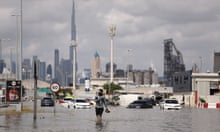
Desert city of Dubai floods as heaviest rainfall in 75 years hits UAE

'I want to go home': passengers stranded by Dubai extreme floods – video

What the desert city of Dubai looks like after its biggest rainfall in 75 years – video

Weather tracker: Gulf braced for thunderstorms
Most viewed.

IMAGES
COMMENTS
New Zealand tour guide Hayden Marshall-Inman, 40, who worked for White Island Tours, was confirmed to have died by his family on Tuesday although he is still officially listed as missing by New ...
Survivors of one of New Zealand's worst natural disasters have described the searing pain of being lashed by burning sand, ash and rocks during a volcanic eruption on Whakaari or White Island in ...
Background Whakaari / White Island in 2013. Whakaari / White Island is an active andesite stratovolcano, situated 48 km (30 mi; 26 nmi) off the north-northeast coast of the North Island of New Zealand in the Bay of Plenty.The volcano has erupted many times in recent history, including several times in the 1980s. A major eruption formed a new crater in 2000, and small eruptions occurred in 2012 ...
An American couple who were badly burned when Whakaari/White Island erupted in December 2019, killing 22 of the 47 people in its crater, told a New Zealand court that neither their guides nor ...
The trial over the deadly 2019 Whakaari White Island eruption has heard there was a 5 per cent chance multiple people would die during tours of the volcano. ... Whakaari White Island disaster ...
White Island volcanic eruption of 2019, volcanic eruption on December 9, 2019, on Whakaari/White Island, located off the coast of eastern North Island, New Zealand, which resulted in the deaths of 22 individuals and injured numerous others. At the time of the eruption, 47 people (adventure tourists ... The disaster plunged New Zealand into a ...
White Island Tours, which took visitors to the island via boat, was fined $517,000 and ordered to pay $5 million in reparations to the victims involved in its tours. ... Survivors of the Whakaari White Island disaster will give accounts of how the tragedy forever changed their lives, when the sentencing of companies guilty of safety failings ...
A U.S. honeymoon couple who survived severe burns when New Zealand's White Island volcano erupted in 2019 are listed as the first witnesses to testify in a trial of tourism industry operators over the disaster that ... 2019, following a volcanic eruption on Dec. 9. Three helicopter tour operators pleaded guilty on Friday, July 7, 2023, to ...
White Island trial: Australian witness says no warnings were given ahead of deadly volcano eruption 13 Jul 2023 Couple who survived White Island volcano tell court they weren't warned of danger
Sentencing for the tour booking agents and managers of an island in New Zealand where a volcanic eruption killed 22 people, mostly tourists, in 2019 began on Monday, with the prosecutor warning ...
This eruption took place on Whakaari/White Island, New Zealand, on 27 April 2016, more than three years before the catastrophe in December last year that claimed the lives of 21 people (17 of them Australians) and injured 26 others. Geologists from GNS Science, NZ's leading provider of geoscientific research, reconstructed the pulses of the ...
The White Island Tours website says it operates through the various alert levels, but "there is always a risk of eruptive activity". At 2.17pm, police are alerted to the disaster.
White Island, the most active cone volcano in New Zealand, is pictured shortly after the blast. (AP)Stephanie Browitt suffered burns to 70 per cent of her body, but survived the incident that ...
00:42. Shocking footage of the White Island eruption shows the moment cruise ship tourists watched the volcano erupt. The majority of the victims of the December 2019 disaster were passengers on ...
Experienced New Zealand tour guide, Hayden Marshall-Inman died during the White Island explosion Photograph: Facebook His brother, Mark Inman, told The Project New Zealand : "He was a guy that ...
White Island volcano survivors sue Royal Caribbean and New Zealand tour company 05:21. New Zealand authorities filed safety violation charges on Monday against 10 organizations and three ...
The criminal trial into the Whakaari White Island disaster has heard evidence from an Australian survivor who lost both his parents and his only sister in the 2019 eruption.
At the time, 47 people, including tour groups and their guides, were on the island, seeking a glimpse of the raw edge of New Zealand's geological activity. Those caught in the disaster included ...
WML, tour operator White Island Tours, various other tourism firms and New Zealand's volcano monitoring agency, the GNS Science and the National Emergency Management Agency, were also charged.
The volcano on Whakaari, also known as White Island, after the eruption in December 2019. The cruise company Royal Caribbean is taking legal action against survivors of the disaster.
12. Hosted by Michael Barbaro. Featuring Jonah E. Bromwich. Produced by Rikki Novetsky , Will Reid , Lynsea Garrison and Rob Szypko. Edited by Paige Cowett. Original music by Dan Powell , Marion ...
Passengers report being stranded in the desert city as the international hub struggles in the wake of unusually heavy rain